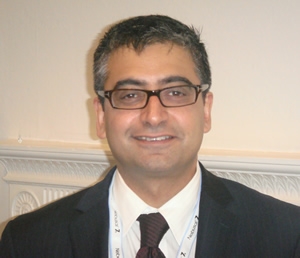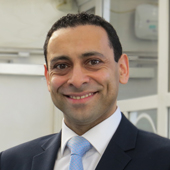2011
2011
Accurso FJ, Moss RB, Wilmott RW, Anbar RD, Schaberg AE, Durham TA, Ramsey BW. TIGER-1 Investigator Study Group. Denufosol tetrasodium in patients with cystic fibrosis and normal to mildly impaired lung function. Am J Resp Crit Care 2011; 183:627-634.[PubMed]

Fig 1. Frank Accurso CU Anschutz Newsroom
Denufosol is a novel ion channel regulator designed to correct the ion transport defect and increase the overall mucociliary clearance in cystic fibrosis lung disease by increasing chloride secretion, inhibiting sodium absorption, and increasing ciliary beat frequency in the airway epithelium independently of cystic fibrosis transmembrane conductance regulator genotype. OBJECTIVES: To evaluate the efficacy and safety of denufosol in patients with cystic fibrosis who had normal to mildly impaired lung function characteristic of early cystic fibrosis. METHODS: A total of 352 patients greater than or equal to 5 years old with cystic fibrosis who had FEV(1) greater than or equal to 75% of predicted normal were randomized to receive inhaled denufosol, 60 mg, or placebo three times daily in a Phase 3, randomized, double-blind, placebo-controlled, 24-week trial.
MEASUREMENTS AND MAIN RESULTS: Main outcome measures included change in FEV(1) from baseline to Week 24 endpoint and adverse events. Mean change from baseline to Week 24 endpoint in FEV(1) (primary efficacy endpoint) was 0.048 L for denufosol (n = 178) and 0.003 L for placebo (n = 174; P = 0.047). N
No significant differences between groups were observed for secondary endpoints including exacerbation rate and other measures of lung function. Denufosol was well tolerated with adverse event and growth profiles similar to placebo.
The authors concluded Denufosol improved lung function relative to placebo in cystic fibrosis patients with normal to mildly impaired lung function.
— However, unfortunately a second Phase III trial (TIGER 2), a 48 week trial, did not confirm these findings and the primary endpoint of this TIGER 2 trial (change in FEV% at 48 weeks) did not achieve significance. As a result of these findings the open label study that followed was abandoned. This was very sad as Denufosol was one of the main drugs under development during the past decade from the first reports of the next generation P2Y(2) receptor agonists in CF in 2002 (Yerxa BR et al J Pharmacol Exp Ther 2002; 302: 871-880) [PubMed].
Ao M, Venkatasubramanian J, Boonkaewwan C, Ganesan N, Syed A, Benya RV, Rao MC. Lubiprostone activates Cl- secretion via cAMP signaling and increases membrane CFTR in the human colon carcinoma cell line, T84. Digest Dis Sci 2011; 56:339-351. [PubMed]
Lubiprostone, used clinically (b.i.d.) to treat constipation, has been reported to increase transepithelial Cl(-) transport in T84 cells by activating ClC-2 channels. To identify the underlying signalling pathway, the authors explored the effects of short-term and overnight lubiprostone treatment on second messenger signaling and Cl(-) transport.
Lubiprostone and the cAMP stimulator, forskolin, caused comparable and maximal increases of I(sc) in T84 cells. Lubiprostone activates Cl(-) secretion in T84 cells via cAMP, protein kinase A, and by increasing apical membrane CFTR protein.
Dr Mei Ao is at the Department of Physiology and Biophysics, University of Illinois at Chicago, Chicago, IL 60612, USA.
— The precise action of lubiprostone in CF is still under investigation in the laboratory and also there is a short publication of its use in adults with CF for constipation where there did seem to be some beneficial effect (O’Brien et al. Ann Pharmacother 2011; 45:1061-1066. [PubMed]).
Subsequently, there was a steady output of studies concerning the effect of Lubiprostone on various epithelial cells. the most recent in 2022. (pubmed.ncbi.nlm.nih.gov/35680165/)
2011 Association of Chartered Physiotherapists in Cystic Fibrosis (ACPCF) “Standards of Care and Good Clinical Practice for Physiotherapy Management Cystic Fibrosis” edited by Penney Argent, Lisa Morrison and Ammani Prasad
This is an excellent review of the subject and available on the CF Trust website (www.cysticfibrosis.org.uk) or the ACPCF website (www.csp.org)

Fig 2. Penny Argent

Fig 3. Lisa Morrison

Fig 4. Ammani Prasad
Penney Argent (fig. 2) is deputy Director of Rehabilitation and Therapies at the Royal Brompton and Harefield Hospitals, London and a professional lead for physiotherapy.Her directorate has about 100 staff members and includes an adult cystic fibrosis team.
Lisa Morrison (fig. 3) has worked in cystic fibrosis for the past 19 years, first at the Regional CF Centre in Leeds with the last 12 as Clinical Specialist Physiotherapist in the Adult CF Centre at the Gartnavel Hospital, Glasgow. She is particularly interested in exercise management and has presented locally and nationally on this topic. Lisa is involved both nationally and internationally with various aspects of CF physiotherapy.
Ammani Prasad (fig. 4) . Following qualification Ammani specialised in paediatric respiratory care, working extensively in the fields of paediatric intensive care and paediatric respiratory medicine, particularly cystic fibrosis. More recently Ammani has been involved in coordinating the work within the Cystic Fibrosis Unit at Great Ormond Street Hospital (GOSH). She is involved in joint work with the Cystic Fibrosis Trust and Department of Health regarding clinical pathways, commissioning of cystic fibrosis care and Peer Review. She now manages the Cystic Fibrosis Unit at (GOSH).
Aurora P, Stanojevic S, Wade A, Oliver C, Kozlowska W, Lum S, Bush A, Price J, Carr SB, Shankar A, Stocks J. London Cystic Fibrosis Collaboration. Lung clearance index at 4 years predicts subsequent lung function in children with cystic fibrosis. Am J Respir Crit Care 2011; 183:752-758. [PubMed]

Fig. 5 Paul Aurora
author’s photo
There is an urgent need for alternative surrogates that detect early lung disease and track through early childhood.
This study aimed to determine whether multiple-breath washout (MBW) results at preschool age can predict subsequent abnormal lung function.
Preschool children (3-5 yr) with CF and healthy control subjects underwent spirometry and MBW with testing repeated during early school age (6-10 yr). Primary outcomes were FEV1 from spirometry and lung clearance index (LCI) from MBW.
Forty-eight children with CF and 45 healthy children completed testing. Thirty-five (73%) children with CF had abnormal LCI at preschool age, whereas only five had abnormal FEV1. The positive predictive value of preschool LCI for predicting any abnormal school-age result was 94%, with a negative predictive value of 62%. Only one child with abnormal FEV1 at school age had had a normal preschool LCI. In contrast, for preschool FEV1 the positive predictive value was 100%, but negative predictive value was only 25%.
The authors concluded that their study demonstrates that an abnormal preschool LCI predicts subsequent lung function abnormalities, whereas a normal preschool LCI usually remains normal.
— The study provides more evidence that the Multiple Breath Washout test has potential as a clinical and research outcome in young children with CF. Undoubtedly a major advance is measuring respiratory function in young children – so it proved to be.
Bermudez CA, Rocha RV, Zaldonis D, Bhama JK, Crespo MM, Shigemura N, Pilewski JM, Sappington PL, Boujoukos AJ, Toyoda Y. Extracorporeal membrane oxygenation as a bridge to lung transplant: midterm outcomes. Ann Thorac Surg 2011; 92:1226-31.

Fig. 6 Christian A Bermudez
pennmedicine.org
In this report from Pittsburg, 17 (1.3%) were supported with ECMO before lung transplant. Diagnoses included retransplantation (n = 6), pulmonary fibrosis (n = 6), cystic fibrosis (n = 4), and chronic obstructive pulmonary disease (n = 1). Fifteen patients underwent double lung transplant, one patient had single left lung transplant and one patient had a heart-lung transplant.
Veno-venous and veno-arterial ECMO were implanted in eight and nine cases, respectively. Median duration of support was 3.2 days (range, 1 to 49 days). Mean patient follow-up was 2.3 years.
Thirty-day, 1-year, and 3-year survivals were 81%, 74%, and 65%, respectively, for the supported patients and 93%, 78%, and 62% in the control group (p = 0.56). Two-year survival was not affected by ECMO type, with survival of five out of nine patients supported by venoarterial ECMO vs seven out of eight patients supported by venovenous ECMO (p = 0.17). At 1- year follow-up, allograft function for the ECMO-supported patients did not differ from the control group (forced expiratory volume in one second, 2.35 L vs 2.09 L, p = 0.39) (forced vital capacity, 3.06 L vs 2.71 L, p = 0.34).
The authors concluded extracorporeal membrane oxygenation as a bridge to lung transplantation is associated with higher perioperative mortality but acceptable mid-term survival in carefully selected patients. Late allograft function did not differ in patients who received ECMO support before lung transplant from those who did not receive ECMO.
Christian A Bermudez (fig. 6) is a cardiothoracic transplant surgeon in Philadelphia.
— A major advance, for those who had reached the end stages of their disease, was the successful introduction of heart-lung transplantation in 1985 by Mr Magdi Yacoub at Harefields Hospital, London (Yacoub et al, 1990 above; Scott et al, 1988 above). The possibility of successful treatment in what had been previously the terminal stages of the condition had a major influence on both prognosis and the treatment of severely affected individuals. The first results of heart-lung transplantations in the mid-Eighties were quite remarkable to observe and were related both to surgical skills, concentrated medical expertise in assessment and after care and also to more successful immunosuppressive therapy to prevent rejection of the transplanted organs. The outlook for such patients has progressively improved over the years and heart-lung transplants have been largely replace by double lung transplants and some centres are performing living donor lung transplantation.
The use of ECMO is a further advance in the treatment used for patients in the terminal phases of the condition as a bridge to transplantation.
Bell SC, Bye PT, Cooper PJ, Martin AJ, McKay KO, Robinson PJ, Ryan GF, Simms GC. Cystic fibrosis in Australia, 2009: results from a data registry. Med J Aust 2011; 195:396-400. [PubMed]

Fig 7. Scott Bell
In 2009, data were submitted on 2986 people (48% female). Median age was 17.6 years and 49% of people were aged 18 years or over. Seventy-eight people were newly diagnosed. Fourteen people died and 14 people underwent lung transplantation in the year. Lung function and nutrition were relatively normal among children but deteriorated (more rapidly) among adolescents. With increasing age, progressive respiratory disease was apparent, and the frequency of CF-related complications and use of health care resources increased. In all age groups, there was a wide range in severity of lung disease and nutritional status. CF remains a progressive respiratory disease and is associated with multisystem complications. The acceleration in disease severity in adolescence and early adulthood suggests that better treatment at these stages is required to further improve survival.
Dr Scott Bell (fig. 7) is head of the Adult Cystic Fibrosis Unit at the Prince Charles Hospital in Queensland and has published on a wide variety of aspects of CF care and research. In 2013 Scott was appointed editor of the Journal of Cystic Fibrosis.
Barr HL, Britton J, Smyth AR, Fogarty AW. Association between socioeconomic status, sex, and age at death from cystic fibrosis in England and Wales (1959 to 2008): cross sectional study. BMJ 2011; 343:d4662.pubmed.ncbi.nlm.nih.gov/21862532/

Fig. 8 Helen L Barr
ResearchGate
To determine the trend in the association between socioeconomic status and sex and median age at death from cystic fibrosis in England and Wales, over the past 50 years. From 1959 to 2008, 6750 deaths were attributed to cystic fibrosis in England and Wales. Males were more likely to die above the annual median age at death than females (from 1959 to 1999, adjusted odds ratio for socioeconomic status 1.28, 95% confidence intervals 1.13 to 1.45; from 2000 to 2008, 1.57, 1.18 to 2.08). Individuals in the highest socioeconomic class were also more likely to die above the median age of death than those in the lowest socioeconomic class (from 1959 to 2000, adjusted odds ratio for sex 2.50, 2.16 to 2.90; from 2001 to 2008, 1.89, 1.20 to 2.97). The authors concluded that socioeconomic status and sex remain strong determinants of survival from cystic fibrosis in England and Wales, and the magnitude of these effects does not appear to have substantially reduced over time.
— An article from an experienced team in Nottingham providing evidence for the relationship that poor socioeconomic factors and female sex are both associated with a lower median age of death in the UK. There was a recent similar study from USA by Michael Schechter (Schechter MS et al. J Pediatr 2009; 155:634-639. [PubMed]). Both these studies now provide firm evidence of the association of socioeconomic status and survival – a fact that had been apparent to clinicians for many years.
Helen L Barr (fig. 8) is at the Nottingham Respiratory Biomedical Research Unit, Division of Respiratory Medicine, University of Nottingham, City Hospital Campus, UK.
Briesacher BA, Quittner AL, Fouayzi H, Zhang J, Swensen A. Nationwide trends in the medical care costs of privately insured patients with cystic fibrosis (CF), 2001-2007. Pediatr Pulmonol 2011; 46:770-776. [PubMed]

Fig. 9 Becky Briesacher
bouve.northeastern.edu
The authors identified 3,273 individuals with CF between 2001 and 2007. Overall, the costs of prescription drugs, outpatient visits, and durable medical equipment increased by 59% during the 7-year period ($18,715 in 2001 vs. $29,718 in 2007, P < 0.001). The proportion of individuals hospitalized increased from 24.0% to 38.9%, P < 0.001. Annual testing of pulmonary function increased 53% (49.9% in 2001 to 76.3% in 2007, P < 0.001) and respiratory cultures more than doubled (27.9-67.5%, P < 0.001). Use of CF-related therapies also significantly increased (dornase alfa, 32.1-52.4%, P < 0.001; oral antibiotics, 54.1-71.8%, P = 0.007). Analyses by age showed the largest increases in total medical care costs occurred for the oldest CF patients (aged >30; $20,536 in 2001 to $56,116 in 2007, P < 0.001) and the youngest (aged <11; $3,060 in 2001 to $31,723 in 2007, P < 0.001). The authors concluded that although improvements in diagnosis and treatment have yielded substantial benefits, they have come at considerable cost, both in terms of treatment burden and health care dollars.
Dr Becky Briesacher (fig 9) at the time was at the Meyers Primary Care Institute, University of Massachusetts Medical School, Worcester, Massachusetts, USA. Subsequently Associate Professor, Department of Pharmacy and Health Systems Sciences, School of Pharmacy and Pharmaceutical Science, Northeastern University.
— The cost of care has received increasing attention as more patients survived for longer and more increasingly expensive therapies became available. These figures relate to the USA but similar data have been collected recently in the UK by the CF Trust.
In 2000 I collaborated with Elaine Cross an accountant from our St James University Hospital Finance Department to estimate the cost of our CF service. This was possible as by this time we had complete patient data on our 161 children computerised and the cost related to 1996 (Littlewood & Cross. Present day treatment of cystic fibrosis: its content and cost. In Bodger K, Daly M, Heatley RV. Eds. Clinical Economics in Gastroenterolgy. Balckwell Science 2000:220-249). The annual cost for our whole clinic of 161 children on full care was £1,701,234 or an average of £10,567 per patient in 1996.
Recent data collected by the CF Trust shows that cost has increased in the UK in a similar manner to that reported in this 2011 study. Undoubtedly, the rising cost, which will occur with the availability of new modulator treatments to correct or nullify the effects of the various mutations, is astronomical and a major problem. Indeed the cost of the new therapies such as Ivacaftor, Orkambi and Trikafta (Kaftrio) was indeed massive problem.
Chang EH, Lacruz RS, Bromage TG, Bringas P Jr, Welsh MJ, Zabner J, Paine ML. Enamel pathology resulting from loss of function in the cystic fibrosis transmembrane conductance regulator in a porcine animal model. Cells Tissues Organs 2011; 194(2-4):249-254. [PubMed]

Fig. 10 Eugene H Chang medicine.arizona.edu
Mice null for Cftr and mice null for Slc4a2 have enamel defects, and there are some case reports of enamel anomalies in patients with CF. In this study the authros demonstrate that both Cftr and AE2 expression increased significantly during the rat enamel maturation stage versus the earlier secretory stage (5.6- and 2.9-fold, respectively). These qPCR data imply that there is a greater demand for Cl(-) and bicarbonate (HCO3-) transport during the maturation stage of enamel formation, and that this is, at least in part, provided by changes in CfTR and AE2 expression. In addition, the enamel phenotypes of 2 porcine models of CF, CFTR-null, and CFTR-DF508 have been examined using backscattered electron microscopy in a scanning electron microscope. The enamel of newborn CFTR-null and CFTRl DeltaF508 animals is hypomineralized. Together, these data provide a molecular basis for interpreting enamel disease associated with disruptions to CFTR and AE2 expression.
– The CF pig model is providing evidence for the cause of enamel defects reported in CF patients
Dr. Eugene H Chang (fig. 10) is at the Department of Otolaryngology, Roy J. and Lucille A. Carver College of Medicine, University of Iowa, Iowa City, Iowa, USA. Subsequently Vice-Chair of the Department of Otolaryngology-Head and Neck Surgery, Division Director of Neurorhinology, and a Professor with tenure at the University of Arizona.
Caras S, Boyd D, Zipfel L, Sander-Struckmeier S. Evaluation of Stool Collections to Measure Efficacy of PERT in Subjects With Exocrine Pancreatic Insufficiency. J Pediatr Gastroenterol Nutr 2011; 53:634-640.[PubMed]

Fig. 11 Steve Caras
LinkedIn
The aim of this study was to was to investigate sparse stool sample collection as an alternative to very unpopular complete 72-hour collection for measurement of stool fat in subjects with exocrine pancreatic insufficiency (EPI). Percentage fat (PF) data from sparse stool samples were compared with 72-hour coefficient of fat absorption (CFA) values. Twelve subjects provided samples for this analysis. Multiple-sample PF values <=30% were greatly predictive for CFA values >=80%, as shown by positive predictive value, sensitivity, and specificity values >=0.89, with high accuracy (AUCs >=0.93).
The authors concluded that sparse stool sampling for percentage fat analysis appears to be a valid, practical alternative to 72-hour CFA determination and has potential as a screening tool in clinical practice to identify both suboptimal dosing in subjects with EPI receiving pancreatic enzyme replacement therapy (PERT) and substantial fat malabsorption in subjects not receiving PERT.
Dr Steve Caras (fig.11) was with Abbott Products Inc, Marietta, GA, USA.at the time of this study.
— This is a useful paper for practical management of the intestinal malabsorption in the clinic although obviously not suitable for research. Unfortunately, in the UK, it is now rare for any objective measure of fat absorption to be made in CF patients to check the adequacy of their pancreatic enzyme replacement therapy.
In Leeds for many years simple microscopy of a small sample of stool was evaluated against faecal fat collections and used as a regular screen to ensure that gross fat malabsorption was not present (Walters MP, et al, Clinical monitoring of steatorrhoea in cystic fibrosis. Arch Dis Child 1990; 65:99-102. above with figures). Also, if there were abdominal complaints, demonstrating the absence of obvious steatorrhea would avoid unnecessarily increasing the dose of pancreatic enzymes but would lead to a search for other causes of the symptoms. So these screening tests are very useful and a significant improvement on symptoms and signs alone. Unfortunately, apparently due to financial cuts, even faecal microscopy has been abandoned in the Leeds CF centre.
In this reviewer’s opinion failure to make some regular simple semi-quantitative measure of intestinal absorption such as simple faecal microscopy or the percentage fat method described here represents suboptimal treatment. It is for this reason that, in an audit of 17 specialist CF centres in the UK, so many patients were receiving unnecessarily high doses of enzymes as a result of merely responding to any abdominal symptoms by increasing the dose of enzymes (Mehta A. Further comments on the fibrosing colonopathy study. Lancet 2001; 358:1547-1548. Above).
Coates AL, Green M, Leung K, Chan J, Ribeiro N, Ratjen F, Charron M. A comparison of amount and speed of deposition between the PARI LC STAR nebulizer and an investigational eFlow nebulizer. J Aeros Med Pulmon Drug Del 2001; 24:157- 163. [PubMed]

Fig 12. Allan Coates
The potency and physical properties of many of the drugs used in the treatment of cystic fibrosis necessitates the use of nebulization, a relatively time-consuming pulmonary delivery method. Newer,faster, and more efficient delivery systems are being proposed. The purposes of this study was to compare the length of time it took to deliver the equivalent of normal saline nebulized for 10 min in a PARI LC STAR nebulizer to that of an investigational PARI eFlow. The investigational eFlow delivered 8.6 +/- 1.0 mg, approximately 90% of the lung dose compared to the LC STAR , 9.6 +/- 1.0 mg, but did in less than half the time (p < 0.02 for both). There were no differences in central versus peripheral distribution for either device. The authors concluded the investigational eFlow was both faster and more efficient than the LC STAR nebuliser.
– One of many studies from Professor Allan Coates (fig. 12) and his colleagues at Toronto aimed at improving the efficiency of inhalation therapy in people with CF confirming the superiority of the eFlow nebuliser. This has been one of his main areas of research.
Colombo C, Littlewood J. The implementation of standards of care in Europe: state of the art. [Review] J Cyst Fibros 2011; 10 Suppl 2:S7-15. [PubMed]Available as a free downloon the ECFS website.

Fig 13 Carla Colombo
We reported the care and condition of people with cystic fibrosis (CF) in 34 European countries using data obtained from publications, registries and professionals providing CF patient care. Care and outcomes differ markedly between countries. Although the 2005 European standards of patient care publication was widely known, in many countries there were no specialized CF centres. In only a minority of countries was funding considered adequate and in some countries costs covered by patients compromised care. Only 15 countries had a national CF patient registry. Neonatal screening was routine in only 10 of the 34 countries, but this did included 59% of European infants. Our suggestions for the future included at least one adequately staffed CF Centre in each country, improved funding, neonatal screening, national patient registries and the formation of national CF parent and patient organisations.
— Carla Colombo (fig. 13) and myself collected much of this information by personal contact with clinicians in Europe to whom we are grateful. The standard of care was very variable and the resources allocated to CF care also varied considerably.
Cuthbert AW. New horizons in the treatment of cystic fibrosis. [Review] Brit J Pharmacol 2011; 163:173-183. [PubMed]

Fig 14. Alan Cuthbert
Alan Cuthbert observes that at long last there appears to be progress with the pharmaco-therapeutic approach. Ongoing clinical trials have produced fascinating results in which clinical benefit appears to have been achieved. To arrive at this point ingenious ways have been devised to screen very large chemical libraries for one of two properties: (i) agents promoting trafficking of mutant CFTR to, and insertion into the membrane, and known as correctors or (ii) agents which activate appropriately located mutant CFTR, known as potentiators. The best compounds emerging from these programmes are then used as chemical scaffolds to synthesize other compounds with appropriate pharmaceutical properties, hopefully with their pharmacological activity maintained or even enhanced.
In summary, this approach attempts to make the mutant CFTR function in place of the real CFTR. A major function of CFTR in healthy airways is to maintain an adequate airway surface liquid (ASL) layer. In CF the position is further confounded since epithelial sodium channels (ENaC) are no longer regulated and transport salt and water out of the airways to exacerbate the lack of ASL. Thus an additional possibility for treatment of CF is to use agents that inhibit ENaC either alone or as adjuncts to CFTR correctors and/or potentiators. Yet a further way in which a pharmacological approach to CF can be considered is to recruit alternative chloride channels, such as calcium-activated chloride channel (CaCC), to act as surrogates for CFTR. A number of P2Y(2) receptor agonists have been investigated that operate by increasing Ca(2+)(i) which in turn activates CaCC. Some of these compounds are currently in clinical trials. The knowledge base surrounding the structure and function of CFTR that has accumulated in the last 20 years is impressive. Translational research feeding from this is now yielding compounds that provide real prospects for a pharmacotherapy for this disease.
Professor Alan Cuthbert (1932-2016) (fig.14) at this time was one of the UK’s leading researchers in the field of CF and although, at the time of this paper, he had retired from the Chair of Pharmacology at Cambridge University he continued being actively involved in research into the pharmacological treatment of CF.
Dalgic B, Egritas O. Gray hair and acrodermatitis enteropathica-like dermatitis: an unexpected presentation of cystic fibrosis. Eur J Pediatr 2011; 170:1305-8.[PubMed]

Fig. 15 Buket Dalgic
avers.gazi.edu.tr
Presentation of cystic fibrosis (CF) with an acrodermatitis enteropathica-like skin rash, anemia, and hypoproteinemia without pulmonary disease is rarely reported before. We describe an 11-month-old boy with rash and edema as the presenting signs of cystic fibrosis. The interesting additional finding in this patient was the graying hair after 3 months of age. A reversal of the gray hair was observed following pancreatic enzyme replacement therapy.
In conclusion, acrodermatitis-like eruption and hypoproteinemia can be a presenting sign of CF. Graying hair has not been noticed so far as a sign of CF in these patients
Prof. Buket Dalgic (fig.15) is in the Department of Pediatric Gastroenterology, Gazi University School of Medicine, Ankara, Turkey.
— Yet another presentation of CF. The acrodermatitis as the presenting disorder of CF has been described previously, related to the multiple dietary deficiencies in untreated patients, but the greying hair is new and interestingly was reversed after pancreatic enzyme therapy was started.
Debray D, Kelly D, Houwen R, Strandvik B, Colombo C. Best practice guidance for the diagnosis and management of cystic fibrosis-associated liver disease. [Review] J Cyst Fibros 2011; 10 Suppl 2:S29-36. [PubMed]

Fig. 16 Dominque Debray co-transplantation
Approximately 5-10% of cystic fibrosis (CF) patients develop multilobular cirrhosis during the first decade of life. Most CF patients later develop signs of portal hypertension with complications, mainly variceal bleeding. Liver failure usually occurs later, after the paediatric age. Annual screening for liver disease is recommended to detect pre-symptomatic signs and initiate ursodeoxycholic acid therapy, which might halt disease progression. Liver disease should be considered if at least two of the following variables are present: abnormal physical examination, persistently abnormal liver function tests and pathological ultrasonography. If there is diagnostic doubt, a liver biopsy is indicated. All CF patients with liver disease need annual follow-up to evaluate the development of cirrhosis, portal hypertension or liver failure. Management should focus on nutrition, prevention of bleeding and variceal decompression. Deterioration of pulmonary function is an important consideration for liver transplantation, particularly in children with hepatic dysfunction or advanced portal hypertension.
These are the European guidelines for the management of CF liver disease authored by leading European paediatric CF liver specialists. These are available on the ECFS website
Dr Dominique Debray (fig. 17) is at Pediatric Hepatology, APHP-CHU Necker-Enfants Malades and INSERM, UMR-S 938, Centre de Recherche Saint-Antoine, Paris, France.
De Boeck K, Vermeulen F, Wanyama S, Thomas M, members of the Belgian CF Registry. Inhaled corticosteroids and lower lung function decline in young children with cystic fibrosis. Eur Respir J 2011; 37:1091-1095. [PubMed]

Fig. 16 Kris De Boeck
A recent American registry analysis in cystic fibrosis (CF) children showed less lung function decline after starting inhaled corticosteroid (ICS) use. The authors therefore examined the influence of ICS treatment on lung function in Belgian CF patients.
Data from patients >= 6 yrs of age were eligible, provided entries on lung function, height and ICS use were available in two consecutive years. Data after oral steroid use or transplant were excluded. 852 subjects contributed data with 2,976 data pairs analysed, 44.9% concerning years of ICS use.
Yearly % predicted decline in forced expiratory volume in 1 s (FEV1) was 1.07% lower during ICS use (p = 0.001). Subgroup analysis for age revealed that the lower FEV1 decline rate during ICS use was only statistically significant in children 6-12 yrs of age (2.56%; p = 0.0003). Baseline FEV(1) was lower by 5.89% (p < 0.0001) in ICS users for all age groups combined, but there was no difference in baseline lung function in the children 6-12 yrs of age. In 6-12-yr-old children with CF, baseline lung function was similar in ICS users and nonusers, but annualised FEV1 decline was 2.56% pred lower in ICS users. The Belgian data therefore support recent American findings.
Dr Kris de Boeck (fig 17) is Professor at Paediatric Pulmonology, University of Leuven, Leuven, Belgium.
— Many trials of inhaled corticosteroids did not reach the standards considered adequate by Cochrane reviewers in 2009 – “evidence from these trials is insufficient to establish whether ICS are beneficial in CF, but withdrawal in those already taking them has been shown to be safe”!. The Cochrane reviewers’ observation regarding withdrawal of steroids refers to the study of Balfour-Lynn (Balfour-Lynn IM et al. Am J Respir Crit Care 2006; 173:1356-1362).[PubMed] However it important to note that there were patients considered for that study whose paediatricians were unwilling to withdraw the steroid treatment; so more accurately steroids could be withdrawn in the majority but not all of children.
Also experience indicates that they do have a beneficial effect presumably by reducing the damaging inflammation in the airways as one could predict and they are widely used as was apparent from the Ian Balfour-Lynn study referred to above.
The 2021 CF Foundation Registry report shows no less than 30.7% of patients 6 years and above were taking inhaled corticosteroids – although not recommended!
Geller DE, Flume PA, Staab D, Fischer R, Loutit JS, Conrad DJ, Mpex 204 Study Group. Levofloxacin inhalation solution (MP-376) in patients with cystic fibrosis with Pseudomonas aeruginosa. Am J Resp Crit Care 2011; 183:1510-6. [PubMed] Free download available.

Fig 18. David Geller
This study assessed the efficacy and safety of a novel aerosol formulation of levofloxacin (MP-376, Aeroquin) in a heavily treated CF population with P. aeruginosa (PA) infection. This study randomized 151 patients with CF with chronic PA infection to one of three doses of MP-376 (120 mg every day, 240 mg every day, 240 mg twice a day) or placebo for 28 days. The primary efficacy endpoint was the change in sputum PA density. Secondary endpoints included changes in pulmonary function, the need for other anti-PA antimicrobials, changes in patient-reported symptom scores, and safety monitoring.
All doses of MP-376 resulted in reduced sputum PA density at Day 28, with MP-376 – 240 mg twice a day showing a 0.96 log difference compared with placebo (P = 0.001). There was a dose-dependent increase in FEV(1) for MP-376, with a difference of 8.7% in FEV(1) between the 240 mg twice a day group and placebo (P = 0.003). Significant reductions (61-79%) in the need for other anti-PA antimicrobials were observed with all MP-376 treatment groups compared with placebo. MP-376 was generally well tolerated relative to placebo
The authors concluded that nebulized MP-376 was well tolerated and demonstrated significant clinical efficacy in already heavily treated patients with CF with PA lung infection.
– Another useful inhaled antibiotic preparation that seems to be very effective in patients who are already receiving treatment. Phase III trials are in progress and started enrolling in late 2010.
Dr David Geller (fig.18) is an experienced paediatric pulmonoloigist and medical consultant for various Biotech, Pharma and Device companies. He has a particular interest and expertise in inhaled therapy. Much of his research and from his laboratory concerns more effciient methods of delivering drugs particulaarly to small children.
George PM, Banya W, Pareek N, Bilton D, Cullinan P, Hodson ME, Simmonds NJ. Improved survival at low lung function in cystic fibrosis: cohort study from 1990 to 2007. BMJ 2011; 342:d1008. [PubMed]

Fig. 19 Peter George
rbht.nhs.uk
To evaluate the survival of patients with cystic fibrosis whose lung function has deteriorated to a forced expiratory volume in one second (FEV(1)) below 30% predicted in the recent treatment era and to explore factors associated with any change in survival.
276 patients (147 (53%) male) attending the Brompton whose FEV(1) was first observed to be less than 30% predicted between 1 January 1990 and 31 December 2003. The median survival improved from 1.2 years in the 1990-1 group to 5.3 years in the 2002-3 group, with a marked improvement in survival from 1994. The use of nebulised recombinant human DNase was significantly associated with a reduced risk of death (hazard ratio 0.59, 95% confidence interval 0.44 to 0.79). Significantly increased risks were associated with a body mass index under 19 (hazard ratio 1.52, 1.10 to 2.10), long term oxygen therapy (3.52, 2.49 to 4.99), and nebulised antibiotics (1.84, 1.05 to 3.22).
The authors concluded that a marked improvement has occurred in the survival of patients with cystic fibrosis with an FEV(1) less than 30% predicted. Secondary analyses suggest that some of this improvement may be due to use of recombinant human DNase.
– This is interesting and encouraging data from the UKs major adult CF centre showing a much improved survival for these severely affected patients, presumably related to improved treatment.
Dr Peter George (fig. 19) was academic registrar at the Royal Brompton Hospital London. Subsequently Consultant Respiratory Physician and Clinical Lead for Interstitial Lung Disease
Gilchrist FJ, Doherty CJ, Govan JR, Webb AK, Jones AM. Pseudomonas aeruginosa bacteraemia in an adult with cystic fibrosis and acute appendicitis. J Cyst Fibros 2011; 10(6):477- 8. [PubMed]

Fig. 20 Francis Gilchrist
LinkedIn
Despite their high bacterial load, bacteraemia is rare in patients with cystic fibrosis (CF). We report an adult with CF who developed Pseudomonas aeruginosa bacteraemia during an episode of acute appendicitis. The Pseudomonas aeruginosa isolated from the blood culture was confirmed by molecular typing to be the same transmissible strain responsible for the patient’s chronic pulmonary infection. The authors suggest that the bacteraemia was caused by Pseudomonas aeruginosa in swallowed sputum, crossing the inflamed appendiceal wall and entering the blood stream.
— Despite their high bacterial load, bacteraemia is surprisingly rare in patients with cystic fibrosis but it is worth noting that it can and does occur on occasion, as in the present case, and not only in those patients who have indwelling intravenous devices which, not rarely, may become infected.
Dr Francis J Gilchrist (fig 20) was at the Manchester Adult Cystic Fibrosis Centre, University Hospital of South Manchester, Southmoor Road, Manchester, M23 9LT, UK. Subsequently Senior Lecturer and Consultant in Paediatric Respiratory Medicine, University Hospitals of North Midlands.
Gomez Morales L, Garcia Morillo S, Herrera Justiniano JM, Avila Poloswsxd R. Fibrosing colonopathy, an increasing complication of cystic fibrosis. Revista Clinica Espanola 2011; 211(1):63-64. [PubMed]
A 30 year old man with CF had repeated episodes of DIOS followed by ileostomy and eventually colectomy histology showed “clear signs of fibrosing colonopathy”. He took 80,000 IU pancreatic supplements (presumably lipase) daily but the brand is not mentioned in the report. The histology in the report is certainly suggestive of fibrosing colonopathy.
— Undoubtedly there are sporadic cases of fibrosing colonopathy reported in people who are not taking pancreatic enzymes supplements, have never taken such treatment and also in people who do not have CF but who have received mesalazine enteric coated pills for inflammatory bowel disease.
In this reviewer’s opinion there is much evidence to suggest that the coating of these mesalazine pills and the coating of certain brands of pancreatic enzymes, Eudragit L30, are an important factor in the development of fibrosing colonopathy.
Hall GL, Logie KM, Parsons F, Schulzke SM, Nolan G, Murray C, Ranganathan S, Robinson P, Sly PD, Stick SM, Berry L, Garratt L, Massie J, Mott L, Poreddy S, Simpson S. Air trapping on chest CT is associated with worse ventilation distribution in infants with cystic fibrosis diagnosed following newborn screening. PLoS ONE [Electronic Resource].2011; 6:e23932. [PubMed]

Fig. 21 Graham L Hall Twitter.com
The primary objective of this analysis was to determine the relationships between ventilation distribution outcomes and the presence and extent of structural damage as assessed by chest CT in infants and young children with CF. The findings suggest that in early CF lung disease there are weak associations between ventilation distribution and lung damage from chest CT. These finding are in contrast to those reported in older children.
Graham L Hall (fig. 21) is at Respiratory Medicine, Princess Margaret Hospital for Children, Perth, Australia.
— Further research is required to assess the role of ventilation distribution in tracking the progression of lung damage in infants with CF. The detection of even minor abnormalities in infants is of importance and the presence and severity correlated with later progressive damage. This paper lends caution to the suggestion that lung clearance index would be a useful method to follow lung involvement in the early years?
Haworth CS, Sharples L, Hughes V, Elkin SL, Hodson ME, Conway SP. Etherington C, Elborn JS, Rendall J, Wheaton E, Kadri E, Elliott J, Barker HC, Bearcroft PW, Hlaing T, Compston JE. Multicentre trial of weekly risedronate on bone density in adults with cystic fibrosis. J Cyst Fibros 2011; 10:470-476. [PubMed]

Fig. 22 Charles Howarth hdruk.ac.uk
The aim of this study was to assess the efficacy, tolerability and safety of risedronate in adults with CF. Patients with a lumbar spine (LS), total hip (TH) or femoral neck (FN) bone mineral density (BMD) Z-score of -1 or less were randomised to receive risedronate 35mg weekly or placebo, and calcium (1g)+vitamin D(3) (800IU). At baseline, BMD Z-scores in the risedronate (n=17) and placebo (n=19) groups were similar. By 24months, 7/17 (41%) risedronate patients vs 0/19 placebo patients stopped the study medication due to bone pain. After 24months treatment, the mean difference (95% CI) in change in LS, TH and FN BMD between the risedronate vs placebo groups was 4.3% (0.4, 8.2) p=0.03; 4.0% (-0.5, 8.6) p=0.08; and 2.4% (-3.5, 8.2) p=0.41.
The authors concluded that after two years treatment there was a significant increase in LS BMD with weekly risedronate compared to placebo.
Bone problems have become one of the many complications encountered as people with CF grow older. Although risedronate was not tolerated by a significant proportion of patients (41%), there did seem to be a positive effective as evidenced by improvement in the bone density of the lumbar spine.
The UK CF Trust have a detailed consensus report relating to this problem the full text of which is on the website – Bone mineralisation in cystic fibrosis. Report of the UK Cystic Fibrosis Trust Bone Mineralisation Working Group. Feb 2007. www.cftrust.org.uk
Dr Charlie Haworth (fig. 22) is Director of the Cambridge Centre for Lung Infection (incorporating The Adult Cystic Fibrosis Centre, The Lung Defence Clinic and The Respiratory Immunology Clinic) at Royal Papworth Hospital. He is also an Honorary Consultant at Addenbrooke’s Hospital in Cambridge.
Hayes D Jr, Feola DJ, Murphy BS, Kuhn RJ, Davis GA. Eradication of Pseudomonas aeruginosa in an adult patient with cystic fibrosis. Am J Health-System Pharm 2011; 68:319-322. [PubMed]

Fig 23. Don Hayes Jr
The use of a continuous infusion of a beta-lactam antibiotic in combination with high-dose, extended-interval amino-glycoside therapy for eradication of Pseudomonas aeruginosa in an adult patient with cystic fibrosis is reported. Testing of an expectorated sputum sample taken during routine evaluation of a 32-year-old woman with CF isolated P. aeruginosa; the patient’s medical record indicated no prior episodes of P. aeruginosa colonization. In an initial attempt to eradicate the organism, the woman received outpatient therapy with oral ciprofloxacin twice daily combined with an aminoglycoside (tobramycin solution) by nebulization twice daily.
After a culture four weeks later again isolated P. aeruginosa, the patient was hospitalized, and i.v. antimicrobial therapy was initiated. The inpatient treatment regimen consisted of continuous-infusion cefepime 6 g (100 mg/kg/24 hr) and i.v. tobramycin 700 mg (12 mg/kg/24 hr), with both drugs administered via a peripherally inserted central catheter, for two weeks. A bronchoalveolar lavage fluid culture performed two months after completion of the i.v. antimicrobial regimen, as well as several sputum cultures obtained during the subsequent three years, tested negative for P. aeruginosa. The administration of continuous-infusion cefepime and high-dose, extended-interval tobramycin led to the successful eradication of P. aeruginosa in an adult patient with CF.
— The 10% or so of patients in whom eradication of P. aeruginosa fails remain a clinical problem and the best form of treatment for them is not clear. This form of treatment has been reported to be successful in a 3-month old infant (Hayes D Jr, et al. Novel approach to the eradication of Pseudomonas aeruginosa in an infant with CF after outpatient treatment failure. Pediatr Pulmonol 2008; 43:511-513. [PubMed]) i.e. using both antibiotics in an optimal manner – to achieve peak levels of aminoglycoside and steady constant levels of the beta-lactam.
It is important to leave no stone unturned when attempting to eradicate P. aeruginosa;this often involves giving intravenous antibiotics to small children with CF who do not appear unwell. In these circumstances it would seem sensible to use the antibiotics in the optimal way as in this present report.
Dr Don Hayes Jr (fig. 23) is Professor of Pediatrics and Internal Medicine at the University of Kentucky and Pediatric Pulmonologist at the Kentucky Children’s Hospital. He has published on a broad range of paediatric and adult respiratory problems including transplantation usually as the first author. This is his second paper on eradication of Pseudomonas after inhaled antibiotic therapy has failed.
Haupt ME, Kim EE, Prestridge AL. Successful prolonged use of recombinant human insulin-like growth factor-1 in a child with cystic fibrosis. Pediatr Pulmonol 2011; 46:1137-41. [PubMed]

Fig. 24 Mark Haupt health.usnews.com
These authors report the successful prolonged use of recombinant human insulin-like growth factor-1 in an adolescent boy with CF, who demonstrated significant clinical benefits from the therapy.
— Growth failure is a common and complicated process in children with cystic fibrosis. Growth hormone, which is becoming a more commonly used agent in such patients, has demonstrated beneficial effects aside from increased growth velocity. Recently, insulin-like growth factor-1 has gained significant attention in the understanding of growth failure in children with CF. This present report is the first of its use in a child with CF.
Mark E Haupt (fig.24) is at the Division of Pulmonary Medicine, Children’s Memorial Hospital, Northwestern University Feinberg School of Medicine, Chicago, IL 60614, USA
Horsley A, Helm J, Brennan A, Bright-Thomas R, Webb K, Jones A. Gout and hyperuricaemia in adults with cystic fibrosis. J R Soc Med 2011; 104 Suppl 1:S36-9.[PubMed]

Fig 25 Alex Horsely wix.com
Gout has not been described previously as a complication in cystic fibrosis (CF). Nine CF patients presented with symptoms of acute gout – an estimated prevalence of around 2.5% in the adult CF clinic population, compared to a previously described prevalence in the non-CF population of just over 1%. Serum urate is measured routinely at the annual review in this unit. Mean (SD) serum urate was 0.40 (0.09) mmol/L in male CF patients (n = 108) and 0.31 (0.08) mmol/L in female patients (n = 74). This was significantly greater than in historical controls. Thirty-seven percent of male CF patients and 36% of female patients had serum urate levels above the upper limit of normal.
— Although hyperuricemia has been described by a number of authors in people with CF since 1978 (Davidson GP et al, J Pediatr 1978; 93:976-8. [PubMed]; Sack J et al, 1980 Isr J Med Sci 1980: 417-9. [PubMed]) perhaps surprisingly, these authors did not report having observed any individuals with clinical gout. This is in marked contrast to the nine affected patients in the present report. Much of the previous discussion has concerned the possible renal effects. It was usually considered that the older less refined pancreatic enzyme preparations were more likely to cause problems, however the present patients were receiving Creon – perhaps other factors in their treatment or lifestyle (diet, alcohol, medical treatment, etc) were contributory.
Dr Alexander Horsley (Fig.25) is a clinical academic at the University of Manchester and consultant at the Manchester Adult Cystic Fibrosis Centre.
Jadin SA, Wu GS, Zhang Z, Shoff SM, Tippets BM, Farrell PM, Miller T, Rock MJ, Levy H, Lai HJ. Growth and pulmonary outcomes during the first 2yr of life of breast fed and formula-fed infants diagnosed with cystic fibrosis through the Wisconsin Routine Newborn Screening Program. Am J Clin Nutr 2011; 93:1038-47. [PubMed]
The optimal feeding (breast milk, formula, or a combination) for infants with cystic fibrosis (CF) is unknown. Recommendations from the CF Foundation are based on limited data. The authors compared growth and pulmonary outcomes between breast-fed and formula-fed infants through the age of 2 yrs. A total of 103 CF infants born in 1994-2006 and diagnosed through newborn screening in Wisconsin were studied. Breast fed infants were classified by the duration of exclusive breast feeding (ExBF). Exclusive formula-feeding (ExFM) was classified by the formula’s caloric density (i.e., standard [0.67 kcal/mL (20 kcal/oz) (ExFM20)] throughout infancy or high density [>=0.74 kcal/mL (22 kcal/oz) (ExFM22+)] for some duration of infancy). RESULTS: Fifty-three infants (51% of infants) were breast fed and 50 infants (49% of infants) were ExFM. In breast fed infants, the duration of ExBF was <1 mo (53% of infants), 1-1.9 mo (21% of infants), 2-3 mo (17% of infants), and 4-9 mo (9% of infants). In ExFM infants, 23 infants (46%) received a formula with a high caloric density; approximately half (n = 13) of the ExFM infants received the formula by 6 mo of age. Proportionately more infants with pancreatic sufficiency (n = 9) were ExBF >=1 mo (44% of infants), and none of the infants were ExFM22+, compared with infants with meconium ileus (n = 24; 13% of infants were ExBF >=1 mo, and 38% of infants were ExFM22+) or pancreatic insufficiency (n = 70; 25% of infants were ExBF >=1 mo, and 20% of infants were ExFM22+) (P = 0.02). In infants with pancreatic insufficiency, weight z scores declined from birth to 6 mo (P < 0.0001) in infants who were ExBF >=2 mo, and the number of Pseudomonas aeruginosa infections through the age of 2 y was fewer in breast fed than in ExFM infants (P = 0.003) but did not differ by the duration of ExBF.
The authors concluded that for infants with CF, exclusive breast feeding for less than 2 months does not compromise growth and is associated with a respiratory benefit.
Sarah A Jardin is in the Department of Nutritional Sciences, College of Agriculture and Life Sciences, University of Wisconsin, Madison, WI 53706, USA.
— Early nutrition of CF infants is very important and this paper contains much useful information. One striking feature of screened CF infants is the degree of weight loss in the first few weeks before treatment is started and the time required to regain a reasonable nutritional state. It had been suggested that exclusive breast feeding did not provide suffcient energy to support maximal growth. Our own experience of feeding screened CF infants in Leeds also suggested that exclusive breast feeding is adequate for some CF infants (Wolfe et al J Cyst Fibros 2005; 4(S1):S94). See entry of Reardon et al 1984 above for figure of weights of Leeds infants. Obviously an individual approach is required supervised by an experienced dietitian.
Kieninger E, Singer F, Fuchs O, Abbas C, Frey U, Regamey N, Casaulta C, Latzin P. Long-term course of lung clearance index between infancy and school-age in cystic fibrosis subjects. J Cyst Fibros 2011; 10:487-490. [PubMed]

Fig. 26 Elizabeth Kleninger kinderklinik.insel.ch
Multiple breath washout (MBW) measurements have recently been shown to be sensitive for detection of early cystic fibrosis (CF) lung disease, with the lung clearance index (LCI) being the most common measure for ventilation inhomogeneity. The aim of this observational study was to describe the longitudinal course of LCI from time of clinical diagnosis during infancy to school-age in eleven children with CF.
Elevated LCI during infancy was present in seven subjects, especially in those with later clinical diagnosis. Tracking of LCI at follow-up was evident only in the four most severe cases. These are the first longitudinal data describing the long-term course of LCI in a small group of infants with CF. The findings support the clinical usefulness of MBW measurements to detect and monitor early lung disease in children with CF already present shortly after clinical diagnosis.
Elizabeth Kleninger (Fig. 26) is in the Division of Respiratory Medicine, Department of Paediatrics, University Children’s Hospital of Bern, Inselspital, 3010 Bern, Switzerland.
— See later study from Australia, mentioned below, which seems to cast doubt on the value of this test to replace a chest CT scan in the first 2 years (Hall GL, et al. Air trapping on chest CT is associated with worse ventilation distribution in infants with cystic fibrosis diagnosed following newborn screening. PLoS ONE [Electronic Resource].2011; 6:e23932. [PubMed]below. Also Free PMC article).
Keiser NW, Engelhardt JF. New animal models of cystic fibrosis: what are they teaching us?. Curr Opin Pulm Med 2011: 17:478-483. [PubMed]

Fig 27. John Englehardt
Cystic fibrosis pigs and ferrets have provided new models to study the spontaneous development of disease in the lung and pancreas, two organs that are largely spared overt spontaneous disease in cystic fibrosis mice. New cystic fibrosis mouse models are now interrogating CFTR functions involved in growth and inflammation at an organ-based level using conditional knockout technology. Together, these models are providing new insights on the human condition. Basic and clinical cystic fibrosis research will benefit greatly from the comparative pathophysiology of cystic fibrosis mice, pigs, and ferrets. Both similarities and differences between these three cystic fibrosis models will inform pathophysiologically important mechanisms of CFTR function in humans and aid in the development of both organ-specific and general therapies for cystic fibrosis.
John Englehardt (fig. 27) is Director of the Center for Gene Therapy and Professor and Head, Department of Anatomy and Cell Biology in the University of Iowa.
Konstan MW, Wagener JS, Pasta DJ, Millar SJ, Jacobs JR, Yegin A, Morgan WJ. Scientific Advisory Group and Investigators and Coordinators of Epidemiologic Study of Cystic Fibrosis. Clinical use of dornase alpha is associated with a slower rate of FEV1 decline in cystic fibrosis. Pediatr Pulmonol 2011; 46:545-553.[PubMe

Fig. 28 Michael Konstan WebMD
Randomized controlled trials of dornase alpha (Pulmozyme) have shown forced expiratory volume in 1 sec (FEV1 ) to improve in patients with cystic fibrosis (CF) but have not assessed change in the rate of lung function decline. We assessed the relationship of dornase alpha use and FEV1 decline using the Epidemiologic Study of Cystic Fibrosis (ESCF). The dornase alpha group (n = 2,230) had a lower FEV1 % predicted at index and a more rapid decline during the pre-index period. The mean rate of FEV1 decline improved for the dornase alpha group; the improvement was similar in adults and children 8-17 years old but was not statistically significant in adults. The comparator group (n = 5,970) showed no change among adults and an increased rate of decline among children 8-17 years old. The authors concluded the use of dornase alpha for a 2-year period is associated with a reduction in the rate of FEV1 decline.
The authors observe that these results demonstrate the value of using an observational study to assess the association of instituting new therapies in the clinical setting with changes in the rate of FEV1 decline in patients with CF. There is increasing data to show that the newer interventions are having long term benefit as well as significant effects in the clinical trials – for example eradication of early Pseudomonas and longterm rhDNase treatment to mention just two.
Prof.Michael W. Konstan(fig.28) is the Vice Dean for Translational Research and the Gertrude Lee Chandler Tucker Professor of Pediatrics at Case Western Reserve University School of Medicine.
Kongsgaard UE. Frederic Chopin and his suffering. Tidsskrift for Den Norske Laegeforening 2011; 131:707-710. [PubMed]

Fig. 29 Ulf E Kongsgaard ous-research.no
2010 was the bicentennial of Chopin’s birth. He left more than 230 fantastic compositions, often described as romantic, emotional and poetic. Chopin composed almost exclusively for piano solo and has been called the pianists’ composer. From his teens Chopin suffered from respiratory tract infections, gradually accompanied by haemoptysis, pronounced breathing problems, diarrhoea and loss of weight. He experienced part of his adult life as a period of great suffering. He was 39 years old when he died. The assumed cause of death was tuberculosis, but other possible differential diagnoses have been suggested in recent years. In order to examine the different diagnostic alternatives the author carried out a non-systematic search of the literature in PubMed, Embase, Current Contents, Google and relevant reference books.
The official cause of Chopin’s death was tuberculosis, but the autopsy report has never been found. Both cystic fibrosis and alpha-1-antitrypsin deficiency are possible differential diagnoses that can explain his symptoms. In spite of a disabling disease, Chopin was musically creative right to the end of his life. His suffering must have influenced his musical expression, which is characterized by intimacy and sentimentality. It is unlikely that we will ever find the true cause of death.
– There are numerous references to Frederick Chopin and speculation as to his illness – this is the latest. A Medline search for “Chopin” will retrieve most of these which make interesting reading.
Ulf E Kongsgaaed (fig. 29) is Professor and senior consultant at Oslo University Hospital
Lewindon PJ, Shepherd RW, Walsh MJ, Greer RM, Williamson R, Pereira TN, Frawley K, Bell SC, Smith JL, Ramm GA. Importance of hepatic fibrosis in cystic fibrosis and the predictive value of liver biopsy. Hepatology 2011; 53:193-201. [PubMed]

Fig. 30 Peter J Lewindon
healthpages.wiki
Forty patients with cystic fibrosis (median age = 10.6 years) with abnormal clinical, biochemical, and US findings were subjected to dual-pass percutaneous liver biopsy. Clinical outcomes were recorded over 12 years of follow-up (median = 9.5 years for survivors). Logistic regression and receiver operating characteristic analyses were applied to predict hepatic fibrosis (which was assessed by fibrosis staging and quantitative immunohistochemistry) and the occurrence of PHT. PHT occurred in 17 of 40 patients (42%), including 6 of 7 (17%) who died during follow-up. Clinical examination, serum ALT levels, and US findings failed to predict either the presence of liver fibrosis or the development of portal hypertension (PHT).Fibrosis staging on liver biopsy, where the accuracy was improved by dual passes (P = 0.002, nonconcordance = 38%), predicted the development of PHT (P < 0.001), which occurred more frequently and at a younger age in those with severe fibrosis.
The authors conclude that although clinical modalities currently employed to evaluate suspected CFLD help to identify a cohort of children at risk for liver disease and adverse outcomes but do not predict an individual’s risk of liver fibrosis or PHT development. Liver fibrosis on biopsy predicts the development of clinically significant liver disease. Dual passes help to address sampling concerns. Liver biopsy has a relevant role in the management of patients with suspected CFLD and deserves more widespread application.
Professor Peter J Lewindon (fig. 30) is in the Department of Gastroenterology, Royal Children’s Hospital, Brisbane, Queensland, Australia.
Lenney W, Edenborough F, Kho P, Kovarik JM. Lung deposition of inhaled tobramycin with eFlow rapid/LC Plus jet nebuliser in healthy and cystic fibrosis subjects. J Cyst Fibros 2011; 10:9-14.[PubMed]

Fig 31. Warren Lenney
In CF patients, whole-lung deposition was 40% less with the eFlow rapid compared with LC Plus nebulisers was (8.9±0.8%, and 15.1±6.0%, p>0.05). Nebulisation time was shorter with eFlow rapid compared to LC Plus (7.0min versus 20.0min, p<0.05). Lung deposition in healthy subjects was comparable between both devices. So the eFlow rapid reduces the nebulisation time of tobramycin and can potentially improved compliance in patients with CF.
Professor Warren Lenney (fig. 31) is Professor in the Academic Department of Child Health, University Hospital of North Staffordshire. He has been involved in paediatric respiratory care and research for many years.
Littlewood JM, Connett GJ, Sander-Struckmeier S, Henniges F. Creon 40,000 Study Group. A 2-year post-authorization safety study of high-strength pancreatic enzyme replacement therapy (pancreatin 40,000) in cystic fibrosis. Expert Opin Drug Saf 2011; 10:197-203.[PubMed]

Fig 32. Suntje Sander-Struckmeier
At the request of the Medicines and Healthcare Regulatory Agency and in agreement with the appropriate authorities, an observational, multi-center, non-interventional, post-authorization safety study of high-strength pancreatic enzymes was conducted. RESEARCH DESIGN AND METHODS: Patients with exocrine pancreatic insufficiency due to cystic fibrosis (CF) who had previously taken high doses of pancreatic enzymes received pancreatin 40,000 capsules (Creon 40,000 Minimicrospheres, Abbott GmbH, Hanover, Germany) as part of their normal treatment for up to 2 years. Initial doses were calculated to match previous established doses in lipase units, with adjustment if required. MAIN OUTCOME MEASURES: Safety focused on serious suspected adverse drug reactions. Maldigestion symptoms and body weight were also monitored. Patients were managed according to general guidelines common to all major CF units in the UK, although minor variations were expected. The coefficient of fat absorption was not assessed as this was a safety rather than an efficacy study. RESULTS: Sixty-four patients were enrolled at nine UK centers. Two deaths occurred during the study, which were considered unrelated to therapy by investigators. There were no further serious suspected adverse drug reactions related to pancreatin 40,000 and no cases of fibrosing colonopathy. Daily lipase doses were reduced by 11% after switching to pancreatin 40,000. Maldigestion symptoms improved and mean body weight increased from baseline to last observation (mean + 6.1 kg in patients < 18 years old). CONCLUSIONS: No safety concerns were identified with pancreatin 40,000 therapy for up to 2 years. Daily lipase doses were not increased when switching to pancreatin 40,0
– The association of fibrosing colonopathy (FC) with the introduction of the high strength pancreatic enzymes in the early Nineties resulted in some apprehension when Creon 40,000, an even higher strength enzyme, was introduced. However, FC has never been associated with any preparation of Creon possibly because the preparation does not contain the copolymer Eudragit in the covering. It was to be expected therefore that Creon 40,000 would be well tolerated as was the case.
Dr. Suntje Sander-Struckmeier (fig. 32) is Director of Clinical Development, Abbott Laboratories GmgH, Hannover.
Lutz JK, Lee J. Prevalence and antimicrobial-resistance of Pseudomonas aeruginosa in swimming pools and hot tubs. Int J Environ Res [Electronic Resource] 2011; 8:554-564.[PubMed]
The aim of this surveillance study was to determine the background prevalence and antimicrobial resistance profile of P. aeruginosa in 8 swimming pools and 3 hot tubs. Twenty-three samples (21%) were positive for P. aeruginosa. Resistance was noted to several antibiotic agents. The results of this surveillance study indicate that 96% of P. aeruginosa isolates tested from swimming pools and hot tubs were multidrug resistant. These results may have important implications for cystic fibrosis patients and other immune-suppressed individuals, for whom infection with multidrug-resistant P. aeruginosa would have greater impact. The results underlie the importance of rigorous facility maintenance, and provide prevalence data on the occurrence of antimicrobial resistant strains of this important recreational water-associated and nosocomial pathogen.
– This study from Ohio USA shows 21% of a small sample of indoor swimming pool samples were infected with multidrug resistant P. aeruginosa. Findings from different studies of different environments do vary however but this present finding does seem particularly high. Swimming pools are generally safe provided the recommended programme of maintenance is carried out. – but standards do vary. In a “Which” magazine survey in the UK in 2002 no less than 35 of 61 samples from pools and spas fell outside acceptable microbiological standards. 9 posed a definite and 3 a serious risk to bathers; spa pools were worse than swimming pools.
Jonathan K Lutz is in the Division of Environmental Health Sciences, College of Public Health, The Ohio State University, Columbus, OI 43210, USA.
Lubamba B. Lebacq J. Reychler G. Marbaix E. Wallemacq P. Lebecque P. Leal T. Inhaled phosphodiesterase type 5 inhibitors restore chloride transport in cystic fibrosis mice. Eur Respir J 2011; 37:72-78. [PubMed]

Fig. 31 Bob Arthur Lubamba stemdrc.com
Sildenafil and vardenafil, two selective inhibitors of phosphodiesterase type 5 (PDE5) are able, when applied by intraperitoneal injection, to activate chloride transport in cystic fibrosis (CF) mice homozygous for the F508del mutation. Oral treatment with the drugs may be associated with adverse haemodynamic effects. The authors hypothesised that inhaled PDE5 inhibitors are able to restore ion transport in F508del CF airway epithelium and developed a restraint-free mouse chamber for inhalation studies. PDE5 inhibitors were nebulised for 15 min at concentrations adjusted from recommended therapeutic oral doses for male erectile dysfunction.
They measured in vivo nasal transepithelial potential difference 1 h after a single inhalation of sildenafil, vardenafil or tadalafil in F508del CF and normal homozygous mice. After nebulisation with the drugs in F508del mice, chloride transport, evaluated by perfusing the nasal mucosa with chloride-free buffer containing amiloride followed by forskolin, was normalised; the forskolin response was increased, with the largest values being observed with tadalafil and intermediate values with vardenafil. No detectable effect was observed on sodium conductance.
The authors consider these results confirm the role of PDE5 inhibitors in restoring chloride transport function of F508del CF transmembrane conductance regulator protein and highlight the potential of inhaled sildenafil, vardenafil and tadalafil as a therapy for CF.
Dr Bob Lumbamba (fig. 31) is at the Louvain Centre for Toxicology and Applied Pharmacology, Université Catholique de Louvain, Brussels, Belgium. Subsequently he became Director of In-Vitro Toxicology at Iontox, Michigan (USA), CEO of SciBioix Consulting, Durham (USA) and Director of Mentorship program at STEM DRC Initiative (USA, DR Congo).
— Publications on the effect of phosphodiesterase inhibitors such as sildenafil in CF have appeared since 2003 (Cobb BR et al. Am J Resp Cell Mol 2003; 29:410) [PubMed]including a study from Wales of the effect of sildenafil on nasal cells from people with CF (Dormer RL et al. Thorax 2005; 60:55-59). [PubMed]. Most subsequent work seems to have been carried out on cells or CF mice. It has been suggested that the necessary high doses of the drug for CFTR recovery suggest sildenafil might not be suitable as a therapeutic drug for CF lung disease (Leier G et al. Cell Physiol Biochem 2012; 29:755-790. [PubMed]).
Labombarda F, Pellissier A, Ellafi M, Creveuil C, Ribault V, Laurans M, Guillot M, Bergot E, Grollier G, Milliez P, Zalcman G, Saloux E. Myocardial strain assessment in cystic fibrosis. J Am Soc Echocardiog 2011; 24:1037-1045. [PubMed]

Fig. 32 Fabien Labombarda
ResearchGate
The aim of this work was to evaluate myocardial strain analysis as a tool for the early detection of left ventricular functional changes in patients with cystic fibrosis. A total of 42 consecutive patients (mean age, 24 +/- 7.5 years; 52% men) diagnosed with cystic fibrosis and referred for echocardiographic cardiac function assessment were prospectively enrolled. A group of healthy age-matched and gender-matched volunteers (n= 42) formed the reference population for echocardiographic comparisons.
Left ventricular ejection fraction was conserved in both groups but was significantly lower in the cystic fibrosis group. Cardiac function assessment using Doppler tissue imaging parameters revealed that both systolic and diastolic measurements differed between the two groups: mitral peak systolic and diastolic velocities, as well as septal and lateral wall strain rates, were decreased in patients with cystic fibrosis, as was longitudinal strain of both the septal and lateral walls.
The authors concluded that using strain measurements, subclinical changes in left ventricular function were found in patients with cystic fibrosis.These parameters were correlated with the degree of pulmonary involvement severity. These findings have potentially significant clinical implications for the outcomes and follow-up of patients with cystic fibrosis, meriting further studies.
Dr Fabian Labombarda (fig.32) is in the Department of Cardiology, CHU de Caen, Caen, France.
— In past years there were more studies on cardiac complications, particularly cor pulmonale when lung involvement was early and severe affecting most children and adolescents in the years before they died. The first report on cardiovascular manifestations of CF appeared in 1952 when the first few children survived long enough to develop such complications (Nadas AS et al. Pediatrics 1952; 10:319-327. above.).
As survival increases and people with CF can be expected to reach middle age and beyond it is timely that attention is again being given to the cardiac implications of many years of pulmonary disease and also perhaps to inherent cardiac abnormalities related to the CF. It is perhaps reassuring that in the early years of heart-lung transplantation, in the so-called domino procedure, the heart from the CF recipient receiving the donor heart-lungs would be donated to a heart transplant recipient. It is interesting that the non-CF heart transplant recipients who received hearts from people with CF had a relatively good long term survival (76% at 5 years) – in fact, better than patients who received hearts from non-CF patients (65% at 5 years) (Anyanwu AC et al. J Heart Lung Transplant 2002; 21:971-975.[PubMed]).
Lavie M, Vilozni D, Sokol G, Somech R, Szeinberg A, Efrati O. Hospital versus home treatment of respiratory exacerbations in cystic fibrosis. Med Sci Monitor 2011; 17:CR698-703. [PubMed]

Fig. 33 Moran Lavie
Center for Public Leadership
The authors analysed data of 139 home intravenous antibiotic treatments in 54 CF patients (age range12-47 yrs) treated for respiratory exacerbations at the hospital (n=84) and/or at home (n=55). They concluded that hospital treatment for acute respiratory exacerbations in CF may be superior to home treatment, as indicated by a shorter duration of hospitalisation, better improvement in FEV1 in patients with CF-related complications, CFRDM in particular and a trend toward better weight gain.
Dr Moran Lavie (fig.33) is in the Pediatric Pulmonary Unit and the National Center for Cystic Fibrosis, Edmond and Lily Safra Children Hospital, Sheba Medical Center, Tel Hashomer, Israel.
— Intravenous antibiotic treatment has been used at home by some CF units in the USA since the Seventies (Stern RC. Intravenous treatment: where we are and how we got there. In: Doershuk CF, editor. Cystic Fibrosis in the Twentieth Century. Cleveland: AM Publishing, Ltd, 2001:93-111) and in the UK since the mid-Eighties in adults (Winter RJ et al. Lancet 1984; i: 1338-1339) and children (1988 Gilbert J, et al. Arch Dis Child 1988; 63:512-517). Subsequently, numerous studies were published attesting to the feasibility, effectiveness and patient acceptability of home intravenous antibiotic therapy – an obvious major advance in treatment but the efficacy obviously will depend on the medical and nursing staff available and their experience at managing the treatment at home.
Surprisingly, (or perhaps not so surprising!!) a Cochrane Review in 2000, updated in 2012, considered only one small study as suitable for inclusion out of 18 they identified, which showed home therapy did not harm the patients!!!!! Despite this unenthusiasitic review, undoubtedly home IV therapy was one of the major advances in treatment and remains a central and very important component of CF treatment at most major units. Failure of a CF Centre to provide this option for some patients would be regarded as a major deficiency. Obviously each patient should be assessed individually and for some home IV treatment would quite inappropriate but for many it remains a major advance in improving their quality of life.
Also, home IV treatment is a major financial saving for the health care providers. As broad estimate in the mid-Nineties 2 weeks home IV antibiotic treatment cost £1500 whereas the same treatment in hospital cost £2500 (Littlewood JM. 1995 Glaxo study to evaluate the cost of hospital vs. home IV treatment in cystic fibrosis. Presented at British Thoracic Society Meeting London 1995).
Massam J, Bitnun A, Solomon M, Somers GR, Guerguerian AM, van Wylick R, Waters V. Invasive aspergillosis in cystic fibrosis: a fatal case in an adolescent and review of the literature. [Review]. Pediatr Infect Dis J 2011; 30:178-180. [PubMed]

Fig. 34 Joanna Massam nygh.on.ca
Invasive aspergillosis is a rare complication of cystic fibrosis. In this article, we describe a case of an adolescent with cystic fibrosis, which was well-controlled previously, colonised with Aspergillus fumigatus. The patient developed fatal disseminated aspergillosis in the absence of any preexisting risk factors after a short course of intravenous corticosteroid treatment.
— Aspergillus and other fungi appear to be an increasing problem for people with CF. Allergic bronchopulmonary aspergillosis (ABPA) has usually been the main problem but more recently aspergillus bronchitis has been reported in six patients with CF, and the fungus should be considered as a definite pathogen that can cause exacerbations (Shoseyov D, et al. Aspergillus bronchitis in cystic fibrosis. Chest 2006; 130:222-226) [PubMed]. Other reports have concerned systemic aspergillosis during immunosuppression therapy following organ transplantation; apparently one of the first heart lung transplant patients in the UK died of invasive aspergillosis.
Dr Joanna Massam (fig. 34) is with the North York General Hospital Toronto and the Division of Respiratory Medicine, Department of Pediatrics, Hospital for Sick Children, University of Toronto, Toronto, Ontario, Canada.
Meyer KC, Francois ML, Thomas HK, Rad ford KL, Haw es DS, Mack TL, Cornwell RD, Maloney JD, De Olivary NC. Colon cancer in lung transplant recipients with CF: increased risk and results of screening. J Cyst Fibros 2011; 10:366-369. [PubMed]

Fig. 35 Keith Meyer medicine.wisc.edu
Four of 70 transplant recipients with CF developed fatal colon carcinoma following transplantation, and the cancer was advanced in all 4 recipients (age 31, 44, 44, 64 yrs) at the time of diagnosis. In contrast, only one of 287 recipients transplanted for non-CF indications developed colon cancer. Of all recipients with CF who did not develop colon cancer, 20 recipients underwent screening colonoscopy at 1 to 12 years following transplantation. Seven (35%) of the screened transplant recipients (ages 36, 38, 40, 41, 43, 49, 51) had colonic polyps in locations ranging from cecum to sigmoid colon and up to 3 cm in diameter.
The authors concluded that in contrast to non-CF recipients, patients with CF displayed a significant incidence of colon cancer (4 of 70 recipients; 5.7%) with onset ranging from 246 days to 9.3 years post-transplant, which may be due to a combination of their underlying genetic disorder plus intense, sustained immunosuppression following lung transplantation. Colonoscopic screening may identify patients with pre-malignant colonic lesions and prevent progression to colonic malignancy.
Dr Keith Meyer (fig.35) is a pulmonologist with the Section of Allergy, Pulmonary and Critical Care Medicine, Department of Medicine, University of Wisconsin School of Medicine and Public Health, Madison, WI, USA.
— This study from the Wisconsin CF Centre confirms the increased risk for developing cancer after transplantations and immunosuppression in people with CF. The finding of colonic polyps in 7 (35%) of transplant recipients is important suggesting the need for colonoscopic screening of such patients.
McCormack P, McNamara PS, Southern KW. A randomised controlled trial of breathing modes for adaptive aerosol delivery in children with cystic fibrosis. J Cyst Fibros 2011;. 10:343-349. [PubMed]
Modern nebulisers have reduced treatment times by utilising mesh technology for aerosol production. A further modification (target inhalation mode (TIM)) that may reduce treatment delivery times further. Following a baseline period on tidal breathing mode (TBM), children with CF on long-term aerosol therapy were randomly allocated to either TIM, which optimises patient inhalations through a direct feedback mechanism, or to continue TBM. The primary outcome was nebuliser treatment times with secondary outcomes being adherence and patient preference. The ten children allocated TIM reduced their mean (SD) treatment times from 6.9(2.9) to 3.7(2.3) minutes (p<0.001). In contrast, treatment times were unchanged in the ten children allocated TBM. Mean adherence was maintained in the TIM group but declined in patients allocated TBM by >5%. All children preferred TIM to TBM. The authors concluded that TIM reduces nebuliser treatment times and may positively impact on adherence, although longer duration studies are required to examine this.
Pamela McCormack is Clinical Specialist Physiotherapist at the Alder Hey Children’s Hospital Liverpool UK
— This seems to be a definite advance in improving the efficiency and acceptability of inhalation therapy which is central to modern treatment of CF. Previous evaluation in adults with CF also provided evidence of acceptability and efficacy (Denyer J et al. J Aerosol Med Pulm Drug Deliv 2010 April 23 Suppl 1:S29-S36). [PubMed] above).
McLachlan G, Davidson H, Holder E, Davies LA, Pringle IA, Sumner-Jones SG, Baker A, Tennant P, Gordon C, Vrettou C, Blundell R, Hyndman L, Stevenson B, Wilson A, Doherty A. Shaw DJ, Coles RL, Painter H, Cheng SH, Scheule RK, Davies JC, Innes JA, Hyde SC, Griesenbach U, Alton EW, Boyd AC, Porteous DJ, Gill DR, Collie DD. Pre-clinical evaluation of three non-viral gene transfer agents for cystic fibrosis after aerosol delivery to the ovine lung. Gene Ther 2011; 18:996-1005. [PubMed]

Fig. 36 Gerry McLachlan
ed.ac.uk
The UK Gene Therapy Consortium report the use of a large animal model to assess three non-viral gene transfer agents (GTAs): 25 kDa-branched polyethyleneimine (PEI), the cationic liposome (GL67A) and compacted DNA nanoparticle formulated with polyethylene glycol-substituted lysine 30-mer. GTAs complexed with plasmids expressing human cystic fibrosis transmembrane conductance regulator (CFTR) complementary DNA were administered to the sheep lung (n=8 per group) by aerosol. All GTAs gave evidence of gene transfer and expression 1 day after treatment. Vector-derived mRNA was expressed in lung tissues, including epithelial cell-enriched bronchial brushing samples, with median group values reaching 1-10% of endogenous CFTR mRNA levels. GL67A gave the highest levels of expression. Human CFTR protein was detected in small airway epithelial cells in some animals treated with GL67A (two out of eight) and PEI (one out of eight). Bronchoalveolar lavage neutrophilia, lung histology and elevated serum haptoglobin levels indicated that gene delivery was associated with mild local and systemic inflammation. Ther authors’ conclusion was that GL67A was the best non-viral GTA currently available for aerosol delivery to the sheep lung, led to the selection of GL67A as their lead GTA for clinical trials of gene therapy in CF patients.
— The UK Gene Therapy Consortium’s trial of gene therapy started in 2012/13 and the present study confirmed their choice of GL67A as the most suitable gene transfer agent to be used in the trial.. The multidose trial represents the culmination of over 10 years work on the part of the members of the GTC in London, Oxford and Edinburgh largely funded by the UK CF Trust. The presence of mild inflammation was also noticed in the first CF patients treated in the pilot study (Davies JC et al. Safety and expression of a single dose of lipid-mediated CFTR gene therapy to the upper and lower airways of patients with CF. Pediatr Pulmonol 2011; Suppl 34: Abstract 198. Page 281) but does not appear to be a major problem.
Dr Gerry McLachlan (fig. 36) is Group Leader and Senior Research Fellow at the Roslin Institute Edinburgh
Ostedgaard LS, Meyerholz DK, Chen JH, Pezzulo AA, Karp PH, Rokhlina T, Ernst SE, Hanfland RA, Reznikov LR, Ludwig PS, Rogan MP, Davis GJ, Dohrn CL, Wohlford-Lenane C, Taft PJ, Rector MV, Hornick E, Nassar BS, Samuel M, Zhang Y, Richter SS, Uc A, Shilyansky J, Prather RS, McCray PB Jr, Zabner J, Welsh MJ, Stoltz DA. The dF508 mutation causes CFTR misprocessing and cystic fibrosis-like disease in pigs. Science Translational Medicine 2011; 3:74ra24.[PubMed]

Fig. 37. Lynda Ostegaard Carver College of Medicine
To better understand the effects of the dF508 mutation in vivo, we produced CFTR dF508/dF508 pigs. Our biochemical, immunocytochemical, and electrophysiological data on CFTR-dF508 in newborn pigs paralleled in vitro predictions. They also indicated that CFTR dF508/dF508 airway epithelia retain a small residual CFTR conductance, with maximal stimulation producing ~6% of wild-type function. Cyclic adenosine 3′,5′-monophosphate (cAMP) agonists were less potent at stimulating current in CFTR(dF508/dF508) epithelia, suggesting that quantitative tests of maximal anion current may overestimate transport under physiological conditions. Despite residual CFTR function, four older CFTR dF508/dF508) pigs developed lung disease similar to human CF. These results suggest that this limited CFTR activity is insufficient to prevent lung or gastrointestinal disease in CF pigs. These data also suggest that studies of recombinant CFTR-dF508 misprocessing predict in vivo behavior, which validates its use in biochemical and drug discovery experiments.
These findings help elucidate the molecular pathogenesis of the common CF mutation and will guide strategies for developing new therapeutics.
— An important publication outlining some of the features of the recently described CF pigs. The question is often asked “How much CFTR do you need?” Well, according to these findings 6% does not seem to be adequate to prevent lung disease.
Dr Lind Ostegaard (fig. 37) is Research Associate Professor of Internal Medicine Pulmonary Critical Care and Occupational Medicine at the Department of Internal Medicine, Roy J. and Lucille A. Carver College of Medicine, University of Iowa, Iowa City, IA 52242, USA.
Obeid M, Price J, Sun L, Scantlebury MH, Overby P, Sidhu R, Chiriboga CA, Quittell LM. Facial palsy and idiopathic intracranial hypertension in twins with cystic fibrosis and hypovitaminosis A. Pediatr Neurol 2011; 44:150-152. [PubMed]

Fig. 38 Makram M Obeid iuhealth.org
10-week-old monozygotic twins, diagnosed with cystic fibrosis by newborn screening, developed facial palsy and increased intracranial pressure. Cranial imaging and cerebrospinal fluid analysis produced normal results. Levels of serum vitamin A were below the normal range. Low levels of vitamin A are associated with facial nerve paralysis, and are at least partly implicated in the development of increased intracranial pressure in infants with cystic fibrosis.
— Facial palsy is a well documented as associated with low vitamin A levels in CF infants (Keating JP, Feigin RD. Increased intracranial pressure associated with probable vitamin A deficiency in cystic fibrosis. Pediatrics 1970; 46:41-46.[PubMed]); Silman JS et al. Arch Otolarygol 1985; 111:822-825) . [PubMed];Cameron C et al. J Cyst Fibros 2007; 6:241-243) [PubMed]; Basu AP et al. Eur J Paediatr Neurol 2007; 11:240-242). [PubMed]
Dr Makram Obeid (fig. 38) is Assistant Professor of Neurology Division of Pediatric Neurology, Department of Neurology, College of Physicians and Surgeons, Columbia University, New York, New York 10032, USA.
Patel AJ, Raol VH, Jea A. Rare association between cystic fibrosis, Chiari I malformation, and hydrocephalus in a baby: a case report and review of the literature. J Med Case Reports [Electronic Resource] 2011; 5:366.[PubMed]

Fig. 39 Akash J Patel Texas Medical Center
The 9th case of a baby with cystic fibrosis and Chiari I malformation, in this case in a 10-month-old, full-term Caucasian baby boy. There was developmental delay, macrocephaly, bulging anterior fontanelle, and papilledema. An MRI scan demonstrated an extensive Chiari I malformation with effacement of the fourth ventricle, obliteration of the outlets of the fourth ventricle and triventricular hydrocephalus without aqueductal stenosis. A ventriculoperitoneal shunt was inserted.
The authors suggest that the cystic fibrosis transmembrane conductance regulator gene may play a previously unrecognised role in central nervous system development; alternatively, this central nervous system abnormality may have been acquired due to constant valsalva from recurrent coughing or wheezing or metabolic and electrolyte imbalances that occur characteristically in cystic fibrosis.
Dr Akash J Patel (fig. 39) is a neurosurgeon in the Division of Pediatric Neurosurgery, Texas Children’s Hospital, Department of Neurosurgery, Baylor College of Medicine, Houston, TX, USA.
— See also Needleman JP et al. Pediatr Pulmonol 2000; 30:490-492. [PubMed]– also this entry in year 2000 section for illustration of example of the Arnold-Chiari malformation.
Pierucci-Alves F, Akoyev V, Stewart JC 3rd, Wang LH, Janardhan KS, Schultz BD. Swine models of cystic fibrosis reveal male reproductive tract phenotype at birth. Biol Reprod 2011; 85:442-451. [PubMed]

Fig. 40. Fernando Pierucci-Alves loopfrontirsin.org
The goal of this study was to determine the phenotypic changes that may be present in the vas deferens of CF pigs.
Tracts from CFTR(-/-) and CFTR(dF508/dF508) neonates revealed partial or total vas deferens and/or epididymis atresia at birth, while wild-type littermates were normal. Histopathological analysis revealed a range of tissue abnormalities and disruptions in tubular organization. Vas deferens epithelial cells were isolated and electrophysiological results support that CFTR(-/-) monolayers can exhibit Na(+) reabsorption but reveal no anion secretion following exposure to cAMP-generating compounds, suggesting that CFTR-dependent Cl(-) and/or HCO(3)(-) transport is completely impaired. SLC26A3 and SLC26A6 immunoreactivities were detected in all experimental groups, indicating that these two chloride-bicarbonate exchangers were present, but were either unable to function or their activity is electroneutral. In addition, no signs of increased mucus synthesis and/or secretion were present in the male excurrent ducts of these CF models. Results demonstrate a causal link between CFTR mutations and duct abnormalities that are manifested at birth.
Dr Fernando Pierucci-Alves (fig 40) assistant professor the Departments of Anatomy & Physiology, Kansas State University, Manhattan, Kansas 66506, USA.
— So the CF pigs have a similar genital tract abnormality to that present in men with CF which is attributable to the CFTR mutations (Kaplan E et al. N Eng J Med 1968; 279:65-69. above [PubMed]).
Pincikova T, Nilsson K, Moen IE, Karpati F, Fluge G, Hollsing A, Knudsen PK, Lindblad A, Mared L, Pressler T, Hjelte L. Scandinavian Cystic Fibrosis Study Consortium. Inverse relation between vitamin D and serum total immunoglobulin G in the Scandinavian Cystic Fibrosis Nutritional Study. Eur J Clin Nutr 2011; 65:102-109. [PubMed]

Fig. 41 Terezia Pincikova ResearchGate.net
The hallmark of cystic fibrosis (CF) is chronic lung inflammation. The severity of lung disease is closely correlated with immunoglobulin G (IgG) levels. Beyond its contribution to the bone health, the importance of vitamin D has not been fully recognized owing to the lack of human studies providing evidence of its benefit.
In the context of the recently described immunomodulatory functions of vitamin D, the authors aimed to assess the relationship between vitamin D and IgG levels.
Eight hundred and ninety-six CF patients were included (0.53-65.9 years) from seven centres in Denmark, Norway and Sweden. The authors found that Serum 25OHD was positively associated with FEV1 and concluded that increasing vitamin D intake may positively modulate inflammation in CF. This study supports the proposed role of vitamin D in the immune system during infection and substantiates prospective studies.
Terezia Pincikova (fig. 41) îs at the Stockholm Cystic Fibrosis Center, Karolinska Institutet, Karolinska University Hospital Huddinge, Stockholm, Sweden.
— This is a relatively recently suggested role for vitamin D and reinforces the importance of adequately supplementing patients with CF to achieve a normal serum vitamin D level.
Pestana Knight EM, Novelli PM, Joshi SM. Cerebral and systemic infarcts after bronchial artery embolization. Pediatr Neurol 2011; 45:324-327. [PubMed]

Fig. 42 Ella Pestana Knight my.levelandclinic.org
A 17-year-old girl with cystic fibrosis developed hemoptysis and underwent bilateral bronchial artery embolization with 300-500 mum and 500-700 mum microsphere particles. Afterwards, she was delirious and complained of headache, had altered mental status and general hyperreflexia. Her left fifth digit was painful and cyanotic. Neuroimaging demonstrated multiple embolic infarcts in the cerebellum, thalamus, and cerebral hemispheres. She was heterozygous for a prothrombin 20210A mutation. Her functional neurologic recovery was complete.
Ella M Pestina Knight (fig.42) is in the Division of Pediatric Epilepsy, Department of Pediatrics, Case Western Reserve University and Rainbow Babies and Children’s Hospital, Cleveland, Ohio, USA.
— This is the first pediatric case of cerebral and systemic embolism after bronchial artery embolization. Although this complication is not predictable, the authors suggest it should be suspected in patients with underlying chronic lung disease who develop acute neurologic signs after bronchial artery embolization, because these patients are prone to anomalous arterial-arterial shunt formation. Bronchial artery embolization with microspheres constitutes an effective, safe procedure for controlling hemoptysis. However, this was an alarming and previously unreported complication of pulmonary artery embolisation treatment of haemoptysis. The more usual occasional complication is embolisation of the spinal arteries with the risk of paralysis.
Reid DW, Blizzard CL, Shugg DM, Flowers C, Cash C, Greville HM. Changes in cystic fibrosis mortality in Australia, 1979-2005. Med J Australia 2011; 195:392-395. [PubMed]

Fig. 43 David Reid qimrberghofer
Between 1979 and 2005, the mean age at death increased from 12.2 years to 27.9 years for males and from 14.8 years to 25.3 years for females. Overall, female deaths in childhood (0-14 years) occurred at an age-standardised rate of 0.40 per 100,000 (95% CI, 0.34-0.45) during 1979-2005, which exceeded the corresponding rate for males of 0.24 (95% CI, 0.20-0.28) per 100,000. Among 0-14-year-old boys, event rates declined markedly after 1989, but they declined later and more gradually for girls, with the result that the age-standardised rate for girls was 2.38 times that of boys during 1989-2005 (95% CI, 1.69-3.36).
The authors concluded that the pattern of CF mortality in Australia has changed substantially. Mortality rates continue to be higher for girls than for boys, but death in childhood has become uncommon. Survival has increased since 1979, but females continue to have reduced length of life.
Dr David W Reid (fig. 43) is Director of the Adult Cystic Fibrosis Centre at the Department of Thoracic Medicine, The Prince Charles Hospital, Brisbane, QLD.
Ramsey BW, Davies J, McElvaney NG, Tullis E, Bell SC, Drevinek P, Griese M, McKone EF, Wainwright CE, Konstan MW, Moss R, Ratjen F, Sermet Gaudelus I, Rowe SM, Dong Q, Rodriguez S, Yen K, Ordonez C, Elborn JS. VX08-770-102 Study Group. A CFTR potentiator in patients with cystic fibrosis and the G551D mutation. New Engl J Med 2011; 365:1663-72 .[PubMed]

Fig. 44 Bonnie Ramsey peds.uw.edu
The main report of a randomised, double-blind, placebo-controlled trial to evaluate Ivacaftor (VX-770), a CFTR potentiator, in subjects 12 years of age or older with CF and at least one G551D-CFTR mutation. Subjects were randomly assigned to receive 150 mg of ivacaftor every 12 hours (84 subjects, of whom 83 received at least one dose) or placebo (83, of whom 78 received at least one dose) for 48 weeks. The primary end point was the estimated mean change from baseline through week 24 in the percent of predicted forced expiratory volume in 1 second (FEV(1)).
RESULTS: The change from baseline through week 24 in the percent of predicted FEV(1) was greater by 10.6 percentage points in the Ivacaftor group than in the placebo group (P<0.001). Effects on pulmonary function were noted by 2 weeks, and a significant treatment effect was maintained through week 48. Subjects receiving Ivacaftor were 55% less likely to have a pulmonary exacerbation than were patients receiving placebo, through week 48 (P<0.001). In addition, through week 48, subjects in the ivacaftor group scored 8.6 points higher than did subjects in the placebo group on the respiratory-symptoms domain of the Cystic Fibrosis Questionnaire-revised instrument (a 100-point scale, with higher numbers indicating a lower effect of symptoms on the patient’s quality of life) (P<0.001). By 48 weeks, patients treated with Ivacaftor had gained, on average, 2.7 kg more weight than had patients receiving placebo (P<0.001). The change from baseline through week 48 in the concentration of sweat chloride, a measure of CFTR activity, with Ivacaftor as compared with placebo was -48.1 mmol per liter (P<0.001). The incidence of adverse events was similar with ivacaftor and placebo, with a lower proportion of serious adverse events with Ivacaftor than with placebo (24% vs. 42%). The authors concluded that Ivacaftor was associated with improvements in lung function at 2 weeks that were sustained through 48 weeks. Substantial improvements were also observed in the risk of pulmonary exacerbations, patient-reported respiratory symptoms, weight, and concentration of sweat chloride.
— This is one of the most important papers of recent years and represents the first successful small molecule correction of the effects of a specific CF gene mutation, G551D. It is the first such treatment of the basic defect that has significantly changed the abnormal sweat chloride concentration in addition to favourably influencing the clinical condition of the treated patients.
Dr Bonnie Ramsey (fig. 44) is Professor and Vice Chair of Research Endowed Chair of Cystic Fibrosis, Director, Center for Clinical and Translational Research Director, CF Therapeutics Development Network Coordinating Center Seattle Children’s Research Institute.
Renna M, Schaffner C, Brown K, Shang S, Tamayo MH, Hegyi K, Grimsey NJ, Cusens D, Coulter S, Cooper J, Bowden AR, Newton SM, Kampmann B, Helm J, Jones A, Haworth CS, Basaraba RJ, DeGroote MA, Ordway DJ, Rubinsztein DC, Floto RA. Azithromycin blocks autophagy and may predispose cystic fibrosis patients to mycobacterial infection. J Clin Invest 2011; 121:3554-63. pubmed.ncbi.nlm.nih.gov/21804191/

Fig. 45 Maurizio Renna LinkedIn
A recent study reported that azithromycin use in patients with CF is associated with increased infection with nontuberculous mycobacteria (NTM). This study confirms that long-term azithromycin use by adults with CF is associated with the development of infection with NTM, particularly the multi-drug-resistant species Mycobacterium abscessus, and identifies an underlying mechanism. In primary human macrophages, concentrations of azithromycin achieved during therapeutic dosing blocked autophagosome clearance by preventing lysosomal acidification, thereby impairing autophagic and phagosomal degradation. As a consequence, azithromycin treatment inhibited intracellular killing of mycobacteria within macrophages and resulted in chronic infection with NTM in mice.
The findings emphasize the essential role for autophagy in the host response to infection with NTM, reveal why chronic use of azithromycin may predispose to mycobacterial disease, and highlight the dangers of inadvertent pharmacological blockade of autophagy in patients at risk of infection with drug-resistant pathogens.
(Autophagy = “the segregation of part of the cell’s own protoplasmic material within an membrane and its digestion after fusion of the segregated vacuole with a lysosome”). As many people with CF now receive long term azithromycin treatment further information on this association will be awaited with interest.
Maurizio Renna (Fig. 45) is a Research Associate in the Department of Medical Genetics, Cambridge Institute for Medical Research, University of Cambridge, Cambridge, United Kingdom.
Rosenfeld M, Davis S, Brumback L, Daniel S, Rowbotham R, Johnson R, McNamara S, Jensen R, Barlow C Ratjen F. Inhaled hypertonic saline in infants and toddlers with cystic fibrosis: short-term tolerability, adherence, and safety. Pediatr Pulmonol 2011; 46:666-671. [PubMed]

Fig. 46 Margaret Rosenfield Seattle Children’s
A three-center, open label evaluation of the short-term tolerability, adherence, and safety of 7% hypertonic saline (HS) after bronchodilator administered twice daily for 14 days in young children with CF 12-30 months of age. Participants who tolerated the test dose inhaled 7% HS twice daily for 14+/-2 days. Twenty children were enrolled. One was withdrawn due to maternal concern over fussiness with application of the face mask for the test dose. Of the 19 participants administered the test dose, 1 was withdrawn due to test dose intolerance (5%, 95% confidence interval 0, 26%). Eighteen participants completed the study; 1 was intolerant (95% CI 0, 27%) at the final visit due to new wheezes on exam in association with an upper respiratory infection and otitis media. Home symptom diaries demonstrated cough as the main symptom in the hour following inhalation, which decreased in frequency over the study period. Adherence as assessed by daily home diary and returned study drug ampoules was high.
The authors concluded 7% HS appears well tolerated for up to 14 days in infants and toddlers with CF, with high adherence. These results provide encouraging short-term tolerability and adherence data for future trials assessing the safety and efficacy of 7% HS in young children with CF.
— Most studies on 7% hypertonic saline appear to show significant benefit and the treatment has been shown to improve mucociliary clearance by most but not all studies. It seems reasonable to extend this relatively inexpensive and proven treatment to young children most of whom show early changes in the airways.
Margaret Rosenfield (fig. 46) Professor and Associate Vice-Chair for Clinical Research, Department of Pediatrics Seattle Children’s.
Sermet-Gaudelus I, Bianchi ML, Garabedian M, Aris RM, Morton A, Hardin DS, Elkin SL, Compston JE, Conway SP, Castanet M, Wolfe S, Haworth CS. European cystic fibrosis bone mineralisation guidelines. J Cyst Fibros 2011;10 Suppl 2:S16-23. [PubMed]Available on the ECFS website.

Fig. 47 Isabelle Sermet-Gaudelus
Patients with cystic fibrosis (CF) are at risk of developing low bone mineral density (BMD) and fragility fractures. This paper presents consensus statements that summarises current knowledge of the epidemiology and pathophysiology of CF-related skeletal deficits and provides guidance on its assessment, prevention and treatment. The statements were validated using a modified Delphi methodology.
These guidelines are available on the ECFS website.
Isabelle Sermet-Gaudelus (fig. 47) is at the Pôle de Pediatric Multidisciplinaire, Hôpital Necker, Université René Descartes, 75015 Paris, France.
Stafler P, Davies JC, Balfour-Lynn IM, Rosenthal M, Bush A. Bronchoscopy in cystic fibrosis infants diagnosed by newborn screening. Pediatr Pulmonol 2011; 46:696-700. [PubMed]

Fig 48. Patrick Stafler
There is evidence of early functional and structural changes in babies with cystic fibrosis (CF) diagnosed on newborn screening (NBS). The aim of the present study was to determine the yield of bronchoalveolar lavage (BAL) microbiology and cytology, and 24 hr pH monitoring in a group of CF infants diagnosed on NBS.
Infants referred to the Brompton tertiary pediatric respiratory center between July 2007 and November 2009 underwent fiber-optic bronchoscopy (FOB), BAL, and insertion of a 24 hr dual pH probe under a single general anaesthetic. The authors studied 33 infants, median age of 100 days (47-215 days) at the time of bronchoscopy. In 9 of 33 (27%) bacterial organisms were identified. Seven of the nine patients (78%) were asymptomatic and only one had had a positive cough swab prior to bronchoscopy. Neutrophilia was identified in 18/27 (67%) cases with a median of 11% (6-73%). 13/31 (42%) had an abnormal pH study with a pH index >12%.
The authors concluded that the high yield of microbiology, cytology, and pH probe investigations in screened CF infants justifies invasive surveillance. Longitudinal studies to determine if early aggressive treatment results in improved outcome are awaited.
– A study by the experienced paediatric team at the Royal Brompton in London. These results are impressive and confirm the early changes even in screened CF infants. However, most paediatricians, even in CF Centres, would not opt for routine bronchoscopy in screened infants as the experience and facilities may be less satisfactory than at the Brompton. Many would rely on repeated throat and cough swabs. Claire Wainwright’s excellent Australian study of BAL- directed therapy failed to show a major advantage of periodic bronchoscopic surveillance when the infants are reviewed at 5 years (Wainwright CE et al. JAMA; 2011; 306:163-171.[PubMed]below). However, it is clear that lung infection occurs early and close follow up from diagnosis is mandatory for screened infants – it is noted that median age of the infants in the present report at the time of bronchoscopy was over 3 months.
Dr Patrick Stafler (fig 48) from the Department of Paediatric Respiratory Medicine, Royal Brompton Hospital, London, UK. Subsequently Pediatric Pulmonologist at Schneider’s Children’s Medical Center Of Israel,
Stern M, Niemann N, Wieddemann B, Wenzlaff P, on behalf of the German CFQA Group. Benchmarking improves quality in cystic fibrosis care: a pilot project involving 12 centres. Int J Qual health Care 2011; 23:349-56.[PubMed] (Full text is available to download via PubMed entry)

Fig 49. Martin Stern
A group of 12 CF centres in Germany, treating a total of 1200 patients of all ages, enrolled in a nationwide pilot benchmarking project from 2004 to 2007. Key nutritional and respiratory parameters were used as quality indicators. Numerical benchmarks were set and used for ranking. Applying the plan-do-check-act cycle, quality improvement interventions were introduced, such as harmonization of definitions and references, improvement of measurement standards, data quality, completion of missing data, enforcement of early aggressive antibiotic treatment and individual adaptation of dietary counselling. Ranking alone was not sufficient for identification of the best performing centres unless it was accompanied by longitudinal follow-up. Improvement was possible in the 3 years’ period as shown by benchmarking for single centres that introduced new interventions in nutritional and antibiotic treatment most consequently.
CF provides a model of the link between processes of health care delivery and health outcomes of patients. Quality improvement is a continuous goal in CF care with realistic potential as exemplified by our data. Accountability was introduced and transparency was improved by our pilot benchmarking project. Using the benchmarking procedure, our long-term project will reinforce standards, programmes, and individual attitudes and principles to ensure continuous quality improvement in CF health care
Professor Martin Stern (fig. 49) is Head of the Paediatric Department at the University Children’s Hospital, University of Tubingen, Germany. He is involved in many aspects of CF care and research both nationally and internationally.
Suk JS, Lai SK, Boylan NJ, Dawson MR, Boyle MP, Hanes J. Rapid transport of muco-inert nanoparticles in cystic fibrosis sputum treated with N-acetyl cysteine. Nanomedicine UK. 2011; 6:365-675. [PubMed]

Fig 50. Michael Boyle
Sputum poses a critical diffusional barrier that strongly limits the efficacy of drug and gene carriers in the airways of individuals with cystic fibrosis (CF). Previous attempts to enhance particle penetration of CF sputum have focused on either reducing its barrier properties via mucolytics, or decreasing particle adhesion to sputum constituents by coating the particle surface with non-mucoadhesive polymers, including polyethylene glycol (PEG). Neither approach has enabled particles to penetrate expectorated sputum at rates previously observed for non-mucoadhesive nanoparticles in human cervicovaginal mucus.
The authors sought to investigate whether a common mucolytic, N-acetyl cysteine (NAC), in combination with dense PEG coatings on particles, can synergistically enhance particle penetration across fresh undiluted CF sputum. They used high-resolution multiple particle tracking to measure the diffusion of uncoated and PEG-coated nanoparticles in native and NAC-treated CF sputum. They discovered that 200 nm particles, if densely coated with PEG, were able to penetrate CF sputum pretreated with NAC with average speeds approaching their theoretical speeds in water. Based on the rapid penetration of PEG-coated particles in NAC-treated sputum, they determined that the average spacing between sputum mesh elements was increased from 145 +/- 50 nm to 230 +/- 50 nm upon NAC treatment. Mathematical models based on particle transport rates suggest as much as 75 and 30% of 200 and 500 nm PEG-coated particles, respectively, may penetrate a physiologically thick NAC-treated CF sputum layer within 20 min. Uncoated particles were trapped in CF sputum pretreated with NAC nearly to the same extent as in native sputum, suggesting that NAC treatment alone offered little improvement to particle penetration.
The authors concluded that NAC facilitated rapid diffusion of PEG-coated, muco-inert nanoparticles in CF sputum and that their results provided a promising strategy to improve drug and gene carrier penetration in CF sputum, offering hope for improved therapies for CF.
— The N- acetylcysteine story in relation to CF is really quite remarkable. Although declared of no significant value in CF, nonetheless reports of its positive functions keep appearing!!
Professor Michael Boyle (fig 50) is Associate Professor of Medicine and Director of the Adult Cystic Fibrosis Program. His awards include the Clinical Research Award and the Shwachman Award, both from the Cystic Fibrosis Foundation. In addition to his role as Director of the Adult Cystic Fibrosis Program, he is Director of Education and Fellowship Recruiting for the Division of Pulmonary and Critical Care Medicine. He gave a memorable lecture when invited as guest speaker to the UK CF Trust Annual Medical Meeting. Michael Boyle subsequently became President and Chief Executive Officer of the CF Foundation
Treggiari MM, Retsch-Bogart G, Mayer-Hamblett N, Khan U, Kulich M, Kronmal R, Williams J, Hiatt P, Gibson RL, Spencer T, Orenstein D, Chatfield BA, Froh DK, Burns JL, Rosenfeld M, Ramsey BW. Early Pseudomonas Infection Control (EPIC) Investigators. Comparative efficacy and safety of 4 randomized regimens to treat early Pseudomonas aeruginosa infection in children with cystic fibrosis. Arch Pediat Adol Med 2011; 165:847-856. [PubMed

Fig. 51 Miriam M Treggiari scholars.duke.edu
A randomised controlled trial to investigate the efficacy and safety of 4 anti-pseudomonal treatments in children with cystic fibrosis with recently acquired Pseudomonas aeruginosa infection. 304 children with cystic fibrosis aged 1 to 12 years within 6 months of P. aeruginosa detection. Participants were randomized to 1 of 4 antibiotic regimens for 18 months (six 12-week quarters) between December 2004 and June 2009. Participants randomized to cycled therapy received tobramycin inhalation solution (300 mg twice a day) for 28 days, with oral ciprofloxacin (15-20 mg/kg twice a day) or oral placebo for 14 days every quarter, while participants randomized to culture-based therapy received the same treatments only during quarters with positive P. aeruginosa cultures. The primary end points were time to pulmonary exacerbation requiring intravenous antibiotics and proportion of P. aeruginosa -positive cultures.The intention-to-treat analysis included 304 participants. There was no interaction between treatments.
There were no statistically significant differences in exacerbation rates between cycled and culture-based groups or ciprofloxacin and placebo. The odds ratios of P. aeruginosa- positive culture comparing the cycled vs culture-based group were 0.78 (95% CI, 0.49-1.23) and 1.10 (95% CI, 0.71-1.71) comparing ciprofloxacin vs placebo. Adverse events were similar across groups. The authors concluded there was no difference in the rate of exacerbation or prevalence of P. aeruginosa positivity detected between cycled and culture-based therapies; also adding ciprofloxacin produced no benefits.
Miriam M Treggiari (fig. 51) is at the Department of Anesthesiology and Pain Medicine, Seattle Children’s Hospital, WA 98104, USA.
— These results are interesting and perhaps could have been predicted. It is apparent that there are a variety of antibiotic regimens that will eradicate a new growth of P. aeruginosa and these have been routine in many European centres for over 20 years in some clinics. For example there is a very low rate of chronic P. aeruginosa infection in Denmark (Hansen HJ et al. J Cyst Fibros 2008; 7:523-530). where 80% are protected from chronic P. aeruginosa to the age of 15 years; in Leeds (Lee TW et al. Pediatr Pulmonol 2004; 37:104-110). where only 4.3% of children less than 11 years have chronic P. aeruginosa infection and in Brussels (Lebecque P et al. J Cyst Fibros 2006; 5:237-244.) where only 2.8% of patient under 18 years are chronically infected with P. aeruginosa. The main problem appears to be the few patients where the usual treatment fails to eradicate the organism. The optimal use of intravenous ceftazidime (by constant infusion) and tobramycin (once daily IV) has been successful where standard inhalation therapy fails.
Terheggen G, Dieninghoff D, Rietschel E, Drebber U, Kruis W, Leifeld L. Successful non-invasive treatment of stricturing fibrosing colonopathy in an adult patient. Eur J Med Res 2011; 16:411-4. [PubMed]

Fig. 52 Grischa Terheggen ResearchGate
Fibrosing colonopathy (FC) is a rare entity associated with cystic fibrosis (CF). Until now, patients with stricturing FC have usually been treated surgically. In this instance, the authors aimed at avoiding surgery by applying a new conservative approach.An adult with CF developed persistent abdominal pain due to a non-passable stricture in the right transverse colon. Histology confirmed fibrosing colonopathy. Initially he was treated with prednisolone pulse therapy and additive antibiotic therapy. For maintenance therapy he received budesonide. The patient underwent clinical, laboratory and endoscopic follow-up over a three-year period. The stricture healed and was easy to pass. A relapse in the cecum at the ileocecal valve again improved under steroid and antibiotic therapy.The authors present this case as a novel therapeutic approach for advanced stricturing FC in an adult patient which successfully avoided surgery (right hemicolectomy) over a three year follow up.
— Dr Terheggen kindly sent me a copy of the paper. It is important to know the type of enzyme and unfortunately the brand of enzyme was not stated in the paper. The patient apparently took a “high strength pancreatic enzyme preparation” during childhood but only “pancreatin 150,000 IU per day” (presumably lipase). Unfortunately, there are no full thickness biopsies from surgical specimens – all are endoscopic biopsies.
Dr Grischa Terheggen (fig. 52) is in the Department of Medicine, Evangelisches Krankenhaus Duesseldorf, Duesseldorf, Germany.
Tagawa T, Yamasaki N, Tsuchiya T, Miyazaki T, Hara A, Amenomori M, Fujita H, Sakamoto N, Izumikawa K, Yamamoto Y, Kohno S, Hayashi T, Nagayasu T. Immediate single lobar retransplantation for primary graft dysfunction after living-donor lobar lung transplantation: Report of a case. Surg Today 2011;. 41:1447-9.[PubMed]
A 24-year-old man with cystic fibrosis underwent living-donor lobar lung transplantation (LDLLT) with grafts donated from his father, who had mild cirrhosis, and his uncle. The graft from his father failed, and retransplantation was required 44 h after LDLLT, using his sister’s left lower lobe. The retransplantation was successful; 18 months postoperatively, the recipient and all three donors are doing well. The favorable outcome was achieved owing to the complete assessment of all potential donors in advance, and the appropriate decision to perform retransplantation in a timely manner. Whether this life-saving retransplant procedure for unexpected primary graft dysfunction after LDLLT can be justified requires further experience and a longer follow-up.
— Although not in a patient with cystic fibrosis, this heroic treatment reported from Nagasaki, Japan involving three lung lobes from living donors indicates the progress which has been made in this area, although living donor transplants are not practised in the UK. Also there are a number of issues not least the potential for four fatalities as an end result.
Tsutomu Tagawa is in the Division of Surgical Oncology, Department of Translational Medical Science, Nagasaki University Graduate School of Biomedical Sciences, 1-7-1 Sakamoto, Nagasaki, 852-8501, Japan.
Van Goor F, Hadida S, Grootenhuis PD, Burton B, Stack JH, Straley KS, Decker CJ, Miller M, McCartney J, Olson ER, Wine JJ, Frizzell RA, Ashlock M, Negulescu PA. Correction of the F508del-CFTR protein processing defect in vitro by the investigational drug VX-809. Proc Nat Acad Sci USA 2011; 108:18843-84. [PubMed]

Fig.53 Fred van Goor Respiratory Innovation
The authors describe the in vitro pharmacology of VX-809, a CFTR corrector. In cultured human bronchial epithelial cells isolated from patients with CF homozygous for F508del, VX-809 improved F508del-CFTR processing in the endoplasmic reticulum and enhanced chloride secretion to approximately 14% of non-CF human bronchial epithelial cells, a level associated with mild CF.F508del-CFTR corrected by VX-809 exhibited biochemical and functional characteristics similar to normal CFTR.VX-809 represents a class of CFTR corrector that specifically addresses the underlying processing defect in F508del-CFTR As DF508 is the most frequent CF mutation it is hoped that this corrector will be as therapeutically active as indicated in these studies as it is likely that even 14% of normal CFTR activity will ameliorate the main symptoms associated with complete absent CFTR activity. However, the corrector does not seem to have the same dramatic effect on DF508 as VX-770 has on the G551D mutation.The results of VX-770 in patients with the GF551D mutation added great impetus to the small molecule corrector research and there is now major investment in this area by pharmaceutical companies and the CF Foundation who have been the main drivers behind this very succesful research.
Frederik van Goor (fig.53) is a research and development leader with expertise in protein folding and ion channel function as applied to discovery and development of breakthrough therapeutics for cystic fibrosis.
Viviani L, Assael BM, Creme E. ECFS (A) H1N1 study group. Impact of the A (H1N1) pandemic influenza (season 2009-2010) on patients with cystic fibrosis. J Cyst Fibros 2011; 10:370-376. [PubMed

Fig. 54 Laura Viviani LinkedIn
Study to characterise the impact of A (H1N1) infection on CF in a large number of patients from different centres and countries. Twenty-five centres from 10 countries caring for 4698 patients with CF reported data on 110 patients (2.3%), median age 13 years (range 1-39 years). Only 8.8% of the patients had been vaccinated. The main symptoms were fever and respiratory exacerbation requiring IV antibiotics in 53% of the patients; 48% of the patients were hospitalised for an average of 12.9 days (range 2-56) and 31% required oxygen treatment during the time of the infection. Most of the patients recovered and FEV(1) 1 month after the infection was similar to that before the infection. However, 6 patients were admitted to ICU, 5 with mechanical ventilation. Three patients with severe respiratory disease died.The authors comment that A (H1N1) influenza infection caused transient but significant morbidity in most of the patients with CF. However, in a small number of patients with severe lung disease, A (H1N1) influenza was associated with respiratory deterioration, mechanical ventilation and even death.The importance of vaccination against influenza for all people with CF is reinforced by these findings where only 8% of those affected had been vaccinated. Most reports in previous outbreaks show a significant deterioration of the condition of people with CF who contract influenza. It is interesting that FEV1 was similar one month after the infection in most patients despite the fact that 53% had respiratory exacerbations requiring IV antibiotics associated with the flu.
Laura Viviani (fig.54) is a statistician in the Dipartimento di Medicina del Lavoro Clinica del Lavoro L. Devoto, Sezione di Statistica Medica e Biometria G.A.Maccacaro, Università degli Studi di Milano, Italy. Subsequently
Wainwright CE, Vidmar S, Armstrong DS, Byrnes CA, Carlin JB, Cheney J, Cooper PJ, Grimwood K, Moodie M, Robertson CF, Tiddens HA, ACFBAL Study Investigators. Effect of bronchoalveolar lavage-directed therapy on Pseudomonas aeruginosa infection and structural lung injury in children with cystic fibrosis: a randomized trial. JAMA. 306(2):163-71, 2011 Jul 13. [PubMed]

Fig. 55 Claire Wainwright Author’s photo
Despite wide use of oropharyngeal cultures to identify pulmonary infection, concerns remain over their diagnostic accuracy. While bronchoalveolar lavage (BAL) is an alternative diagnostic tool, evidence for its clinical benefit is lacking. OBJECTIVE: To determine if BAL-directed therapy for pulmonary exacerbations during the first 5 years of life provides better outcomes than current standard practice relying on clinical features and oropharyngeal cultures. DESIGN, SETTING, AND PARTICIPANTS: The Australasian Cystic Fibrosis Bronchoalveolar Lavage (ACFBAL) randomized controlled trial, recruiting infants diagnosed with cystic fibrosis through newborn screening programs in 8 Australasian cystic fibrosis centers. Recruitment occurred between June 1, 1999, and April 30, 2005, with the study ending on December 31, 2009. INTERVENTIONS: BAL-directed (n = 84) or standard (n = 86) therapy until age 5 years. The BAL-directed therapy group underwent BAL before age 6 months when well, when hospitalized for pulmonary exacerbations, if Pseudomonas aeruginosa was detected in oropharyngeal specimens, and after P. aeruginosa eradication therapy. Treatment was prescribed according to BAL or oropharyngeal culture results. MAIN OUTCOME MEASURES: Primary outcomes at age 5 years were prevalence of P. aeruginosa on BAL cultures and total cystic fibrosis computed tomography (CF-CT) score (as a percentage of the maximum score) on high-resolution chest CT scan.RESULTS: Of 267 infants diagnosed with cystic fibrosis following newborn screening, 170 were enrolled and randomized, and 157 completed the study. At age 5 years, 8 of 79 children (10%) in the BAL-directed therapy group and 9 of 76 (12%) in the standard therapy group had P. aeruginosa in final BAL cultures (risk difference, -1.7% [95% confidence interval, -11.6% to 8.1%]; P = .73). Mean total CF-CT scores for the BAL-directed therapy and standard therapy groups were 3.0% and 2.8%, respectively (mean difference, 0.19% [95% confidence interval, -0.94% to 1.33%]; P = .74).
CONCLUSION: Among infants diagnosed with cystic fibrosis, BAL-directed therapy did not result in a lower prevalence of P. aeruginosa infection or lower total CF-CT score when compared with standard therapy at age 5 years.This is a major study and the summary is reproduced in full. The results are clear – bronchoscopy guided antibiotic treatment during the first 5 years does not lead to a reduction in the number of infants who have P. aeruginosa infection nor to a significant difference in CT scores.Perhaps the difference between this study and many previous ones, comparing these two methods of bacteriological monitoring, was that the children were followed over a prolonged period and it was not just a comparison of the findings of one isolated BAL and one oropharyngeal culture.
Professor Claire Wainwright (fig. 55) is a paediatric respiratory physician and co-lead for cystic fibrosis services at the Queensland Children’s Hospital, and a professor of paediatrics and child health at The University of Queensland.
Whitaker P, Shaw N, Gooi J, Etherington C, Conway S, Peckham D. Rapid desensitization for non-immediate reactions in patients with cystic fibrosis. J Cyst Fibros 2011; 10:282-285. [PubMed]

Fig. 56 Paul Whitaker reacts.org
Non-immediate hypersensitivity reactions to antibiotics in patients with CF represent a real-life challenge for clinicians. Desensitization is often performed in patients who have exhausted all therapeutic options. Whilst desensitization is an established procedure for immediate reactions the authors assessed the outcomes and safety of desensitization for non-immediate reactions. They retrospectively reviewed 275 desensitization procedures in 42 patients with a range of non-immediate reactions to six commonly used antibiotics. Desensitization was performed using a 7-step rapid intravenous protocol on a normal medical ward. 250 (91%) of overall desensitization procedures were successful; however, this figure incorporates certain individuals having multiple successful procedures. Individual patient success ranged from 55% with tenuously through to 88% with tobramycin. In the 25 patients who failed desensitization the reactions were mild and the majority occurred within 48 h of starting treatment. Prophylactic anti-histamines and steroids did not reduce the risk of reaction. Whilst the mechanisms remain uncertain the authors confirm that rapid desensitization is a safe and effective way of re-introducing an antibiotic to a patient with a non-immediate reaction.Allergic reactions are a very common and important problem for CF patients who are having repeated course of antibiotics over many years. The report provides useful information for those facing these problems.
Paul Whitaker (fig.56) is a Consultant Respiratory Physician at Leeds Teaching Hospitals NHS Trust.
Wilschanski M, Miller LL, Shoseyov D, Blau H, Rivlin J, Aviram M, Cohen M, Armoni S, Yaakov Y, Pugatch T, Cohen-Cymberknoh M, Miller NL, Reha A, Northcutt VJ, Hirawat S, Donnelly K, Elfring GL, Ajayi T, Kerem E. Chronic ataluren (PTC124) treatment of nonsense mutation cystic fibrosis. Eur Respir J 2011; 38:59-69. [PubMed]

Fig 57. Michael Wilschanski
author’s photo
Ataluren (PTC124) allows ribosomal read through of premature stop codons in mRNA. The authors evaluated drug activity and safety in patients with nonsense CF mutations who took ataluren three times daily for 12 weeks at either a lower dose (4, 4 and 8 mg.kg(-1)) or higher dose (10, 10 and 20 mg.kg(-1)). The study enrolled 19 patients (10 males and nine females aged 19-57 yrs; dose: lower 12, higher seven) with a classic CF phenotype, at least one CFTR nonsense mutation allele, and an abnormal nasal total chloride transport. Both ataluren doses were similarly active, improving total chloride transport with a combined mean change of -5.4 mV (p<0.001), and on-treatment responses (at least -5 mV improvement) and hyperpolarisations (values more electrically negative than -5 mV) in 61% (p<0.001) and 56% (p = 0.002) of patients. CFTR function was greater with time and was accompanied by trends toward improvements in pulmonary function and CF-related coughing. Adverse clinical and laboratory findings were uncommon and usually mild.Chronic ataluren administration produced time-dependent improvements in CFTR activity and clinical parameters with generally good tolerability.
Apparently the results in Duchenne muscular dystrophy have been disappointing and the benefits in CF not evident in one study. However, further results in cystic fibrosis are awaited. A international multicentre phase III trial is in progress in 2011 (Konstan MW et al. Pediatr Pulmonol 2011; Suppl 34: Abstract 232. Page 295).
Michael Wilschanski (fig.57) is a paediatric gastroenterologist at Hadassah University Hospital, Mount Scopus POB 24035, Jerusalem, 91240, Israel. Gastroenterology, Hadassah University Hospital, Mount Scopus POB 24035, Jerusalem, 91240, Israel.
Wright FA, Strug LJ, Doshi VK, Commander CW, Blackman SM, Sun L, Berthiaume Y, Cutler D, Cojocaru A, Collaco JM, Corey M, Dorfman R, Goddard K, Green D, Kent JW Jr, Lange EM, Lee S, Li W, Luo J, Mayhew GM, Naughton KM, Pace RG, Pare P, Rommens JM, Sandford A, Stonebraker JR, Sun W, Taylor C, Vanscoy LL, Zou F, Blangero J, Zielenski J, O’Neal WK, Drumm ML, Durie PR, Knowles MR, Cutting GR. Genome-wide association and linkage identify modifier loci of lung disease severity in cystic fibrosis at 11p13 and 20q13.2. Nat Genet 2011; 43:539-546. [PubMed]

Fig 58 Fred Wright
ncsu.edu
A combined genome-wide association and linkage study was used to identify loci causing variation in cystic fibrosis lung disease severity. The authors identified a significant association (P = 3.34 x 10(-8)) near EHF and APIP (chr11p13) in p.Phe508del homozygotes (n = 1,978). The association replicated in p.Phe508del homozygotes (P = 0.006) from a separate family based study (n = 557), with P = 1.49 x 10(-9) for the three-study joint meta-analysis. Linkage analysis of 486 sibling pairs from the family based study identified a significant quantitative trait locus on chromosome 20q13.2 (log(10) odds = 5.03). Our findings provide insight into the causes of variation in lung disease severity in cystic fibrosis and suggest new therapeutic targets for this life-limiting disorder.A number of studies have searched for genetic modifiers of the severity of CF. This is one such study although it is not clear how this knowledge will be used as a therapeutic target unless by modifying the locus described.
Fred A Wright (fig 58) is in the Department of Biostatistics, University of North Carolina at Chapel Hill, Chapel Hill, North Carolina, USA.
Zalar P, Novak M, de Hood GS, Gunde-Cimerman N. Dishwashers – a man-made ecological niches accommodating human opportunistic fungal pathogens. Fungal Biology 2011; 115:997-107 [PubMed]

Fig. 59 Polona Zalar instagram
Enrichment of fungi that may require specific environmental conditions was observed in dishwashers, 189 of which were sampled in private homes of 101 towns or communities. One-hundred-two were sampled from various localities in Slovenia; 42 from other European countries; 13 and 3 from North and South America, respectively; 5 from Israel; 10 from South Africa; 7 from Far East Asia; and 7 from Australia. Isolation was performed on samples incubated at 37C. Species belonging to genera Aspergillus, Candida, Magnusiomyces, Fusarium, Penicillium and Rhodotorula were found occasionally, while the black yeasts Exophiala dermatitidis and Exophiala phaeomuriformis (Chaetothyriales) were persistently and most frequently isolated. Sixty-two percent of the dishwashers were positive for fungi, and 56% of these accommodated Exophiala. Both Exophiala species are known to be able to cause systemic disease in humans and frequently colonize the lungs of patients with cystic fibrosis.The authors conclude that high temperature, high moisture and alkaline pH values typically occurring in dishwashers can provide an alternative habitat for species also known to be pathogenic to humans.
— This is a very detailed paper, the full version of which is available without cost on the internet. In view of the increasing importance of fungal infections such as Aspergillus in people with CF, this is useful information although the presence of these organisms seem to represent a potential more than definite threat at this stage
Polona Zalar (fig. 59) is Assistant Professor in the Biology Department, Biotechnical Faculty, University of Ljubljana, 1000 Ljubljana, Slovenia.


